Book of Artifacts by SirPhoebos
“One Eyeball and Severed Hand to Rule Them All” doesn’t roll off the tongue, admittedly.
Original SA post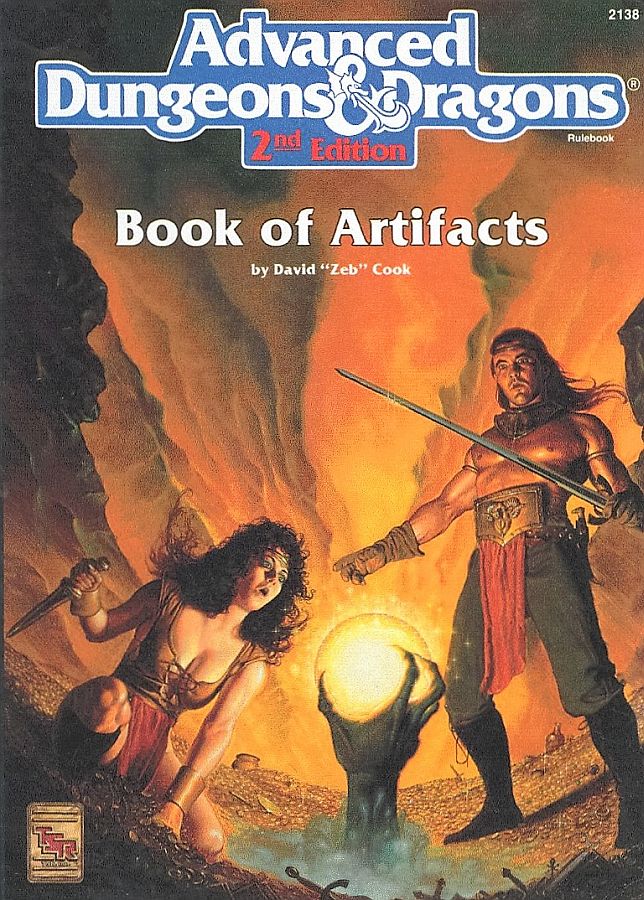
1: “One Eyeball and Severed Hand to Rule Them All” doesn’t roll off the tongue, admittedly.
The Book of Artifacts is one of the first RPG supplements I ever picked up. It came out in 1993 with David “Zeb” Cook as the primary author. Like many 2nd Edition books, it’s about shit that an average group is never going to be involved with. Wee.
We open with Zeb answering what I assume are a bunch of complaints about including artifacts in campaigns. What I don’t know is where these complaints are coming from. Is this from conventions or newsletters? Was someone at TSR checking usenet groups? Some of these complaints come off as strawmen, but that may be because I am writing this review in TYOOL 2016. Maybe “A DM doesn’t have to include an artifact in his campaign if he doesn’t want to” was a major insight in those days. Tellingly, one issue left unaddressed in this section is that whatever player has the artifact is likely to hog all the screen time.
Although artifacts are the main attraction, the book also includes rules for how players create and recharge magical items. Part of the reason why I believe this book was appropriate for F&F is because I think these rules more than anything highlight the difference between 2nd and 3rd edition in how D&D treated spell-casters. To summarize, the rules are such that no player would ever want to waste his or her time with making their own magic item.
We start off with an explanation of what an artifact is in D&D. Mechanically, an artifact is a unique and very old magical item that does not follow the rules of normal magical items and cannot be replicated by the PCs. From a narrative perspective, an artifact is an object around which an entire campaign should be centered. It fills the same role that Stormbringer or The One Ring take in their respective stories. And like The One Ring, D&D artifacts tend to require very specific methods to destroy. Of course, there is a shortcut, the 9th level wizard spell Mordenkainen’s disjunction, but it only works 20% of the time and will attract the attention of whatever big shot made the artifact. Still, given some of the means of destruction suggested, it doesn’t seem like that bad a gamble.
A few artifacts are also known as relics. This just means that the artifact has religious significance to a religion. Otherwise the two terms are interchangeable.
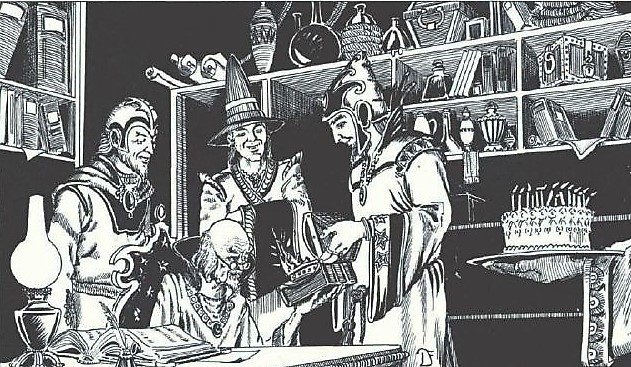
There are guidelines for DMs to design their own artifacts. Given the variety in this book alone, there aren’t any specific steps or charts. The guidelines are that artifacts cheat, that they can’t be created by PCs or any contemporary NPC, that artifacts have a tale attached to them, and that there is a price to using an artifact. We’ll get more into that last point later.
There are some general powers that all artifacts have. Artifacts only radiate dim power to a detect magic spell, and that spell never reveals the type of magic involved. Artifacts are immune to detect evil, identify, know alignment, or locate object. Legend lore and contact other plane will not reveal the location of an artifact, but can be used to learn more about the artifacts power “but the answers are often highly mysterious”
 . Artifacts are immune to physical or magical harm except by the specific means listed in their entries. Finally, the effects of artifacts, particularly curses, are permanent unless otherwise noted.
. Artifacts are immune to physical or magical harm except by the specific means listed in their entries. Finally, the effects of artifacts, particularly curses, are permanent unless otherwise noted.
Let’s talk about those artifact curses, shall we? These range from irritating to “make a new campaign, DM.” The reason artifacts have curses, according to the book, is centered on late eighties adversarial bullshit. In this instance, though, I feel that curses make sense based on what artifacts are trying to emulate. Later editions, even our beloved 4th edition, would stick with even the most beneficial artifacts having catches to using them. Anyway, there are two curses that pop up in several entries: artifact possession and artifact transformation. Artifact possession is the artifact imposing its will and goals on whoever possesses it. An artifact with this drawback has its goals detailed in the curse’s description. The rules for Possession check work like those for intelligent magical items-a check is required when there is a conflict of goals between the user and artifact, plus a mandatory check made every week the object is carried. Artifacts have a Personality Score of 40+1d10. Each time the artifact prevails in these check, it asserts more control over the player. The DM keeps track of how many times the artifacts succeeds. When that number equals the PCs Wisdom score, then that PC is permanently and forever possessed. The book says that players partially possessed have a harder time resisting the artifact or shaking off the effects, but it’s unclear what the mechanical changes are. (“Use the ratio of possessions to total Wisdom as a percentage guide,” the book says. What’s it used for?
 ). The book advises the DM to adjust the rate of Possession checks to fit with the pace of the campaign.
). The book advises the DM to adjust the rate of Possession checks to fit with the pace of the campaign.
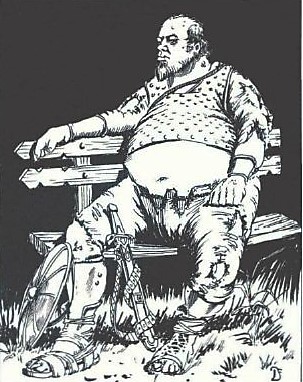
I have no idea what this picture is meant to represent
Artifact transformation changes the physical form of the artifact’s ‘owner’, although apparently it also changes their personality, which seems like it overlaps with artifact possession. Each week, the artifact’s bearer has to make a Save vs. Polymorph at -4, “do not explain to players the purpose of this roll”. If the check fails, then during the week the player shifts closer to the form the artifact desires. Unlike artifact possession, there’s no guideline for how many saves a player needs to fail before the transformation is complete. If the final form is a monster, then the character becomes an NPC. The book tries to emphasis that this curse is never meant to be beneficial, but the example provided does a poor job of selling this. “Oh no, my warrior is becoming ogre-like! I’m so ugly and clumsy, I’m going to cry into my inate 20 strength!
 ”
”
The intro chapter ends with an explanation of how each artifact entry is laid out. The first part is a physical description of the artifact. Next comes the artifact’s history, then how the DM might use the artifact in his or her campaign. After that comes the artifact’s powers, which includes the Curse. Artifact powers fall into two categories: Constant and Invoked. If an artifact is part of a set, then the powers of the combined artifacts are listed as Resonating. Finally, a lot of artifacts have randomly determined powers. In fact, some artifacts are nothing but random powers. There are 24 tables at the back of the book. Two of these tables don’t get referred to by any of artifacts in this book. This is apparently a holdover from AD&D 1st edition, but given all the talk about how artifacts are the centerpiece for a campaign, to even let some of them have random powers is just antithetical. Finally each entry ends with some suggested means of destroying the artifact permanently.
Big Papa V’s Chop Shop
Original SA post
2: Big Papa V’s Chop Shop
The Book of Artifacts has 47 entries, though some of these have multiple items that go together to create a stronger effect. All told, there are 74 objects detailed in this book. I’ll skip over the four that were part of oriongate’s Dark Sun: Psionic Artifacts of Athas write up. I’m going to skip around to and try to post artifacts that are thematically related. For my first group of artifacts I’ll be doing a D&D Artifact Hall of Fame. These artifacts were originally in found in Eldritch Wizardry, one of the oldest supplements for D&D (it was released in 1976), and featured prominently in D&D products over the years.
Before I get started, let’s talk about the Random Power Tables. These tables are located at the back of the book. Some artifacts have no random powers, and some are nothing but random powers. Most have a mixture of set powers and random powers. The book says that in most cases, the DM is “urged” to choose the powers rather than roll because rolling might lead to results that conflict with the artifact’s history. The exception to this recommendation are artifacts that are thematically random. Most of the tables have 20 options, but there are no rules for what a DM should do if they roll the same number twice. Does the DM roll again? Does the ability stack? Is the roll ignored and you get a weaker iteration of an artifact?
 Whatever the case, when an artifact has random powers, I’ll roll on the table, post my results and when a result comes up for the first time, I’ll include it. I’ll get to any results that didn’t come up at the end of this review.
Whatever the case, when an artifact has random powers, I’ll roll on the table, post my results and when a result comes up for the first time, I’ll include it. I’ll get to any results that didn’t come up at the end of this review.
How random powers are used depends on the item. The guideline is that hand-held items need to touch the target to activate, while worn artifacts are activated either by thought or spoken command. Large immobile artifacts either have immediate effects or charge characters with powers to be released later. In instances where the power duplicates a spell, then the spell should operate as if cast by a 20th wizard or priest. Those last two points probably should have been put in the introduction, since they apply equally to fixed powers. Finally, the book says that DMs that need more random tables should go ahead and borrow ones from other games, like the mutation tables from Gamma World.
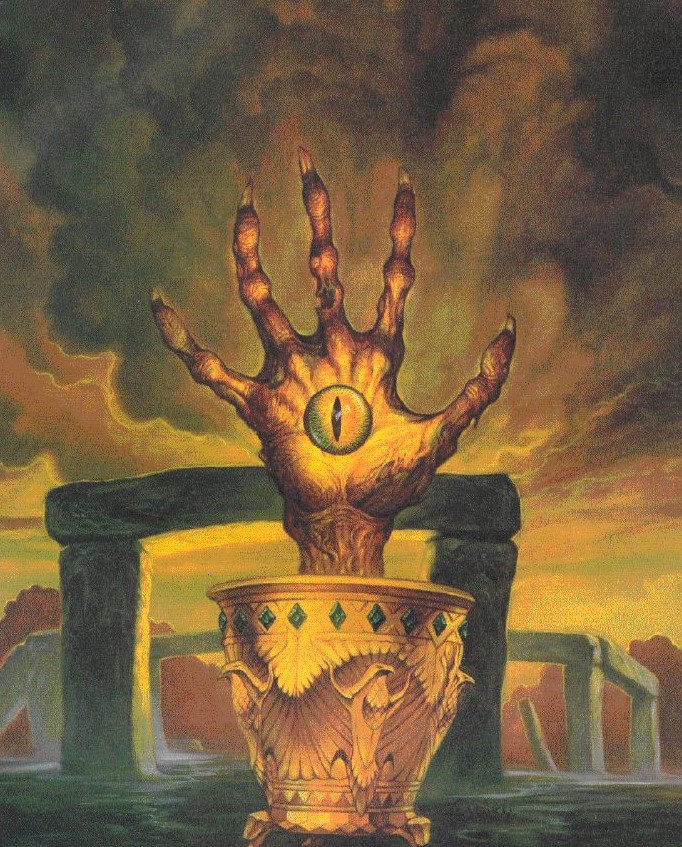
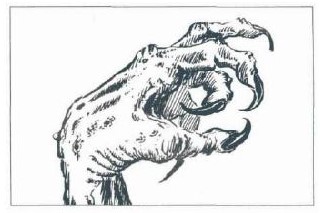
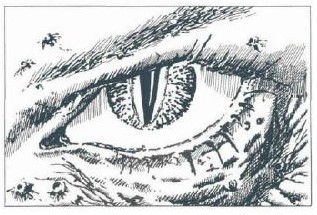
First up are the Eye and Hand
The Hand and Eye are not meant to be used by PCs. Instead, the book suggests having the PCs try to find the artifacts before the cultists and then keep it out of their hands while trying to figure out what to do with them. A variation on this is convincing a good NPC to not use these artifacts. Finally, a baddie can have one or both of these artifacts and the PCs need to do their murderhobo routine on him or her.
To use either artifact, they must be put onto a left arm stump or an empty arm socket. Once placed, they graft into place and have normal functionality in addition to their supernatural powers.
The Hand grants its user 19 Strength, immunity to magic missile and can inflict 2d6 damage by touch to plant based creatures. 1/day, the user can do an instant death touch, no save.
 In addition the hand has 15 random powers; 7 from the
Major Spell-Like Powers table and 8 from the
Minor Spell-Like Powers] table. Both of these tables, which are for spells that don’t fit well in other categories, have more than 20 entries and use a percentage roll instead of a d20.
In addition the hand has 15 random powers; 7 from the
Major Spell-Like Powers table and 8 from the
Minor Spell-Like Powers] table. Both of these tables, which are for spells that don’t fit well in other categories, have more than 20 entries and use a percentage roll instead of a d20.
Major SLP: 64, 70, 72, 85, 63, 9, 80
- 8-10: Cast blade barrier 1/day
- 61-63: Cast prismatic sphere 1/day
- 63-67 (whoops!): Cast ressurection 1/week
- 68-70: Cast reverse gravity 1/day
- 71-73: Cast shades 1/day
- 77-80: Cast telekinesis 3/day
- 84-86: Cast veil 1/day
- 12-13: Cast chill touch 5/day
- 44-45: Cast flaming sphere 5/day
- 49-50: Cast grease 7/day
- 53-54: Cast hold plant 5/day
- 65-66: Cast plant growth 5/day
- 75: Cast shout 3/day
- 99-100: Cast wizard lock 5/day
The Eye of Vecna gives the user a constant true seeing ability. The user can use eyebite 3/day and domination 1/day. The Eye also grants 3 powers from the Divination table.
Divination: 2, 14, 12
- 2: Cast augury 3/day
- 12: Cast foresight 1/week
- 14: Cast know alignment by touch 3/day
Abjurations: 2, 15
- 2: Cast avoidance between creature and user, 1/day
- 15: Cast remove curse by touch 3/day
- 14: Cast extradimensional detection 3/day
- 19: Cast wizard eye 3/day
- 8:Generate a sphere of forbiddance, 15’ radius, centered on artifacts, has a duration of 2d6 hours, can be password locked (1/week)
- 19: Cast undead ward upon a 100’ x 100’ cube. Undead are turned as if by a 18th level priest. (1/week)
The Eye and Hand have the same curse: Artifact Possession eventually turns the user into a Vecna groupee. Only here it’s called Artifact domination and uses different rules (save vs spell every time a power is used, -6 penalty if both artifacts are possessed) from those at the beginning. Maybe these are supposed to be an exception, except it also tells you to refer to the beginning even as it contradicts it.
Suggested Means of Destruction:
- Vecna must be completely and irrevocably destroyed
- It must be cast into the heart of Oerth’s sun
- Every shade of Vecna’s victims must be sent to a peaceful rest
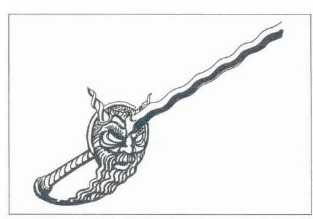
There’s one more artifact associated with Vecna: The Sword of Kas. The description in the book says the Sword has a six foot long blade and a 2 foot long hilt, even though the picture shows a rapier. There’s no indication what the actual base stats the Sword used. Vecna made the sword for Kas, who was his warlord and assassin before going all Starscream. Apparently the sword itself nudged Kas into committing the betrayal, which casts some doubt on how bright Vecna really was. Kas was destroyed in his battle with Vecna, leaving only his sword.
The Sword of Kas is meant to be matched with the Hand and Eye in a campaign. The Sword is single minded in its desire to destroy Vecna and his artifacts. In theory, the Sword acts an “Enemy of my Enemy,” something that the PCs can use against a specific enemy. Whether this works in practice depends on the group, but I feel that being turned into an NPC would be a major disincentive, especially once you account for the curse.
The Sword of Kas is an intelligent weapon (Int 19, Ego 20) and communicates telepathically, and reveals 2 random powers when first touched. It acts as a +6 Defender that does double damage against planar beings, grants foresight, and defiles holy water within 30’ radius. On command, the Sword can bestow shield 3/day or bestow fire giant strength (+4 att/+10 dmg) for 1 turn, 1/day. For random powers, the Sword of Kas has 3 from Immunities and 2 from Major SLP. Powers from the Immunity table are always active.
Immunities: 6, 12, 8
- 6: Imbue the user with immunity to charm- and hold-based spells and spell-like effects, except those caused by artifacts.
- 8: Imbue the user with immunity to all forms of psionics
- 12: Imbue the user with a magic resistance 20% or grant a 20% bonus to any existing magic resistance.
- 87-90: Cast wall of force 1/day
When first touched, the Sword inflicts 2d20 damage (does that apply to enemies you hit?). The wielder risks Artifact Possession, which is again called Artifact Domination. The Sword must be quenched in blood 1/day, and will try to force the PC to do so. “If successful, the character is compelled to kill (even another PC)”. Oh, and all the sword’s powers fail when brought within 60 feet of Vecna or his artifacts. The Sword is not aware of this drawback. I guess the V-man knew what he was doing after all.
Suggested Means of Destruction:
- The death of Vecna
- Be hammered into a plowshare by the cudgel of St. Cuthbert
- All memory of Kas must be wiped from Oerth
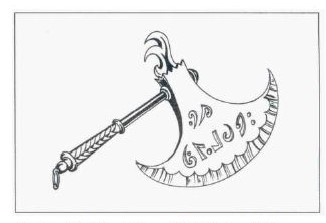
Moving on from Vecna and Friends, we go to a staple of D&D’s artifact inventory, the Axe of the Dwarven Lords. The Axe is one of Five Great Tools made by Silvervein Moradinson, First King of the Dwarves. The other four tools are The Brutal Pick, the Earthheart Forge, the Anvil of Songs, and the Shaping Hammer. Silvervein used the four other items to craft the Fierce Axe, which is what it was originally called. The Axe was passed from ruler to ruler and became the symbol of the One Clan. This golden age came to an end when the reigning king was killed by his nephew. In the ensuing chaos, the Axe disappears.
Although it’s a potent weapon, the Axe of the Dwarven Lords is more like a weaponized Arkenstone than a world-beater in itself. The Axe serves as a focal point for a “Retake the Mountainhomes” campaign, allowing PCs to be the center of attention, juggle the interests of rival dwarf clans, keep it away from Duergar, all while being a nice toy to use for murderhobo-ing. At least that’s the theory. In practice, one part of the curse makes utilizing the Axe touchy
The Axe of the Dwarven Lords is a +3 weapon (no base stats) and has the abilities of a sword of sharpness and a hammer +3 dwarven thrower. It grants dwarven detection and vision abilities at double the normal chance or range. Once a week, the Axe can summon one 16-HD Earth Elemental. The Axe also gets 3 powers from the Elemental Earth table.
Earth Elemental: 3, 5, 4
- 3: Cast conjure earth elemental 1/week
- 4: Imbue the user with the ability to detect depth underground as a dwarf while the artifact is in hand
- 5: Imbue the user with the ability to detect gems while the artifact is in hand.
Non-dwarf character permanently lose 1 point of Charisma when they first touch the Axe. There is a 20% chance that any magical item possessed by the owner is permanently negated (
 ). And lastly, artifact transformation turns the owner into a dwarf if he’s not one already. The second part is the killer for me. Dwarves in 2nd edition had a drawback where there was a 20% chance a magic item they had wouldn’t work, but they had an exception for class-specific gear (so fighters could use armor and weapons, etc). This not only has no such exception, but outright ruins the magic item forever. The Charisma loss is annoying but not crippling, and it’s unlikely this Axe would be introduced if there wasn’t a dwarf PC to begin with.
). And lastly, artifact transformation turns the owner into a dwarf if he’s not one already. The second part is the killer for me. Dwarves in 2nd edition had a drawback where there was a 20% chance a magic item they had wouldn’t work, but they had an exception for class-specific gear (so fighters could use armor and weapons, etc). This not only has no such exception, but outright ruins the magic item forever. The Charisma loss is annoying but not crippling, and it’s unlikely this Axe would be introduced if there wasn’t a dwarf PC to begin with.
Suggested Means of Destruction:
- The Axe must be melted down within the flames of the Earthheart Forge.
- It must be freely given to the deities of the orcs.
- Moradin must be wounded by the Axe.
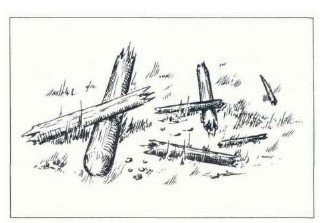
The Rod of Seven Parts rounds out this post. It is a 5-foot-long, black, unadorned pole broken into 7 parts measuring 4, 5, 6, 8, 10, 12, and 15 inches. The pieces are re-assembled in order of ascending length. The Rod harkens back to a time before Good and Evil were added to D&D’s alignment system, because it’s history revolves around an ancient conflict between the Wind Dukes of Aaqa, a.k.a. the Guardians of Law, and the Queen of Chaos. This war is locked in a stalemate until the Queen of Chaos recruits the Miska the Wolf-Spider to command her forces. To counter this new threat, the Dukes of Law create the Rod of Law, and together with the Captains of Law, they confront Miska and his armies at the Battle of Pesh. The Captains strike down Miska with the Rod’s power, banishing him to an unknown Plane, but the Rod is shattered in the process. The Wind Dukes scattered the fragments of the Rod across the world from taking them. Ever since the battle, agents of the Queen have sought out the Rod. Presumably, if the Queen of Chaos can assemble the Rod, she’d be able to bring back Miska.
The Rod’s detailed history gives it a natural adventure hook, “stop the Queen of Chaos from getting the rod and bringing back Miska.” But the book says that the DM may decide that the Rod is best used by NPCs because it’ll turn whoever has it ultra-LN. “This renders most characters effectively unplayable, and few players will even want to attempt it.” I think D&D underestimates the ability of players to be complete spergs. Nevertheless the curse is super-harsh-not even Vecna’s stuff is as immediate as what’s described here.
On their own, each segment has its own unique power, but all the parts convey an impression of the direction in which the next larger piece lies. I guess the idea is that the PCs find the smallest piece first and work from there. As the Rod comes together, it gains additional powers. These powers are as follows:
- 4”: cure light wounds 1/day

- 5”: slow, 23 rounds, 1/day
- 6”: haste, 23 rounds, 1/day (owner doesn’t age)
- 8”: create a 10- by 200-yard gust of wind 5/day
- 10”: true seeing, 20 rounds, 1/day
- 12”: hold monster, 20 rounds, 1/day
- 15”: heal 1/day
- 2-parts: fly at will
- 3-parts: add 20% to magic resistance
- 4-parts: control winds 2/day
- 5-parts: shape change 2/day
- 6-parts: wind walk 1/day
- complete rod: restoration 1/day
In addition, the fully-assembled Rod radiates a specialized 20’-radius fear aura “of fearsome, icy Law.” All enemies “(as defined by the curse)” must make a save vs spell or flee in panic.
Anyone possessing one or more segments of the Rod is immediately turned into an absolute follower of Law and will be compelled to always intervene to uphold Law regardless of consequences. “Anyone, even close friends or even family members, not adhering to the owner’s strict views are perceived as enemies.” Which raises the question of how the Queen of Chaos would be able to get the Rod if anyone taking a piece immediately becomes a Law Drone. Beyond that effect, after acquiring 3 pieces the owner will refuse to part with the segments under any circumstances. Besides alignment nonsense, the biggest problems with the Rod is putting it together, and keeping it from break apart again. Before joining two pieces or a piece to a partially-repaired Rod, extensive wards and glyphs must be placed on each segment. This requires a day of preparation. Otherwise, when two segments are brought within a foot of each other then the newest largest piece will teleport 1d100 miles in a random direction. The direction is determined with a d10, which includes the Cardinal directions plus straight up and straight down. And since it broke once, there’s a 5% chance every time a “major” power is used (no definition of which powers are major) that the rod breaks apart again. If this occurs, then the segments teleport away as above, but twice as far. All the glyphs are ruined if it breaks again.
Suggested Means of Destruction:
- All seven parts are simultaneously joined in the improper order, resulting in a 7d12x10 explosion (no area given)
- Turn the Rod over to the Queen of Chaos.
- Find Miska and force both him and the rod to enter the Plane of Concordant Opposition (i.e. the Outlands)
Scott Jenning’s Kickstarter
Original SA post
3: Scott Jenning’s Kickstarter
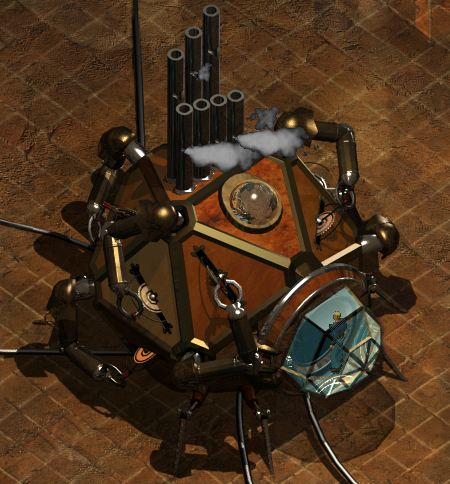
The Machine of Lum the Mad is another artifact that harkens back to Mystic Energies. Players of Baldur’s Gate may have even stumbled on this artifact in their play through. The book describes this artifact differently than how Baldur's Gate depicts it. The Machine is a massive, U-shaped console adorned with no fewer than 60 levers, 40 dials, and a switchboard of sockets, plug and wires. Most of the controls are obviously broken. In the center of the machine is a crystal box 4’x5’x7’, large enough for 4 man-sized creatures to stand in. The whole contraption weighs 2 1/2 tons and fills a good sized chamber. Compared to other artifacts, the Machine of Lum the Mad is pretty fragile.
The Machine was first discovered by Baron Lum, who used the Machine to elevate himself from petty warlord to all-conquering tyrant. Lum was able to master the Machine’s workings, but the process drove him mad. He used the machine to create 50 new species of monsters, and wipe out entire armies, both his enemies and his own. Lum’s reign came to an end in a titanic battle with a former follower, Leuk-O, and the machine was presumed lost.
The Machine is probably the most half-baked artifact in this entire book, both in terms of what it can do and how a DM would incorporate it into his campaign. The book suggests that a DM can make an entire adventure out of attempting to learn learn what one particular setting does. Why the players would seek out the Machine to begin with is left to the DM to figure out. A description of what the Machine could do might provide a motive, but as we’ll see the Machine’s capabilities are really vague.
There’s a page and a half under the Powers subsection Most of it is given over to describing how to use the machine. The book gives a visual aid to help players out, and plays into how to decypher using the machine.
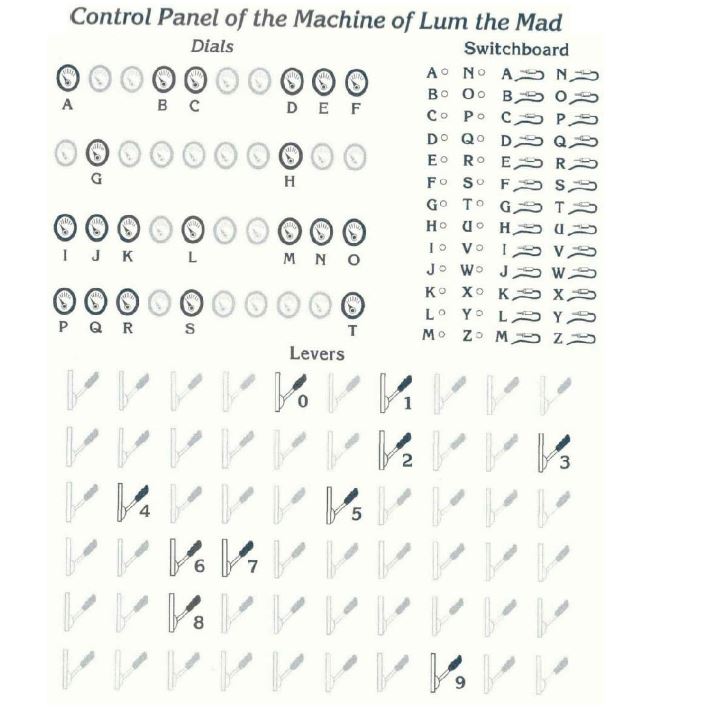
One actual bit of info on the Machine’s abilities that is clear is that certain powers are internal, while others are external. Internal powers affect those inside the crystal box, leaving those outside unaffected, while external powers alter the world outside the box leaving those inside it safe. Anyone inside the box are completely vulnerable to the Machine’s internal powers, not even allowed a save or magical resistance roll. On the other hand, the box protects its contents from all physical, magical, gaseous, and magical attacks.
At this point, we learn that only 35 of the Machine’s powers still function-20 internal, 15 external. Each of these effects has a specific control configuration to activate, and describing these controls is what most of this entry is dedicated to. Of the 60 levers, 10 remain functional. Of the 40 dials, 20 remain functional. There are 26 plugs and 26 sockets. The levers are labeled ‘0’ to ‘9’, the dials are labeled ‘A’ to ‘T’ and can be set from ‘0’ to ‘6’ (0 is the off setting), and the wires and plugs are separately labeled ‘A’ to ‘Z’. Okay, hang on. Are these labels in Common, or do players need a comprehend language spell? Also, the levers have an ‘On’ and ‘Off” position, but how do the players know what that setting is? Finally, one thing that’s not specified is whether the Machine has a master switch or not. According to the book, there are 8.5 x 10 48 possible settings. Is there a risk that in putting in the combination for one power, you accidentally activate a different power?
Anyway, here’s how a DM should write out a combination. The code has three sections. The first part indicates what levers to put in the on position. The second part is for the dials. Dials set to 0 are ignored, while the other dials are noted as letter/number combo. The final part is for connecting plugs to sockets. The book says to list the plug before the socket (so ‘AW’ means connect plug A to socket W), but I would flip that around on account of the diagram putting the socket on the left and the plugs on the right. That aside, the notations are at least clear enough that players won’t confuse a code for one part with another part. To use the example in the book, a possible setting would look like ‘067 : G1/M4/R3 : CB/FH/OM/ST/WQ’
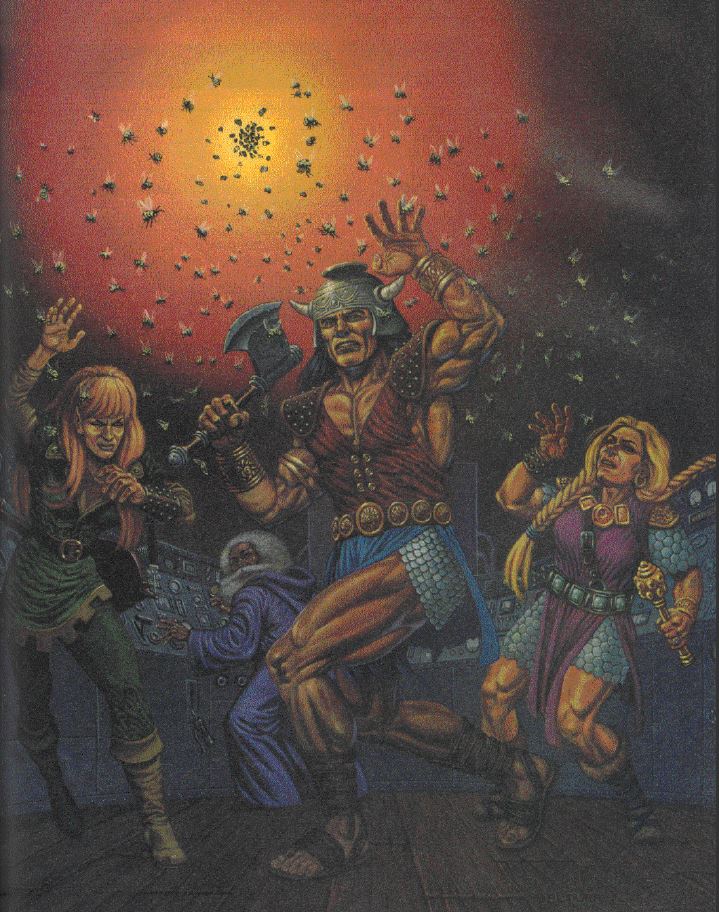
You want bees? ROLL FOR INITIATIVE!”
After a machine is used, there is a 70% chance that some reaction in the machine alters the settings required to duplicate the effect. Presumably, this is to prevent repeated uses of the machine, but it raises some questions: If effects are unlikely to be duplicated, then who is recording these working combinations? If Lum himself recorded the combination, then how would players know for sure that the Machine is still capable of making the power? Did Lum have to worry about the Machine reconfiguring its interface, or is it just a consequence of the machine falling apart? If the players discover a code, would they be able to tell if that power had been used, especially since the user receives no indication of this change?
As for what the Machine actually does it left to the DM, with only the Random Powers tables suggested as a starting point. Gee, thanks, book

The Machine of Lum the Mad has two curses. First, any time the machine is started without a correct combination, the DM rolls on the following table:
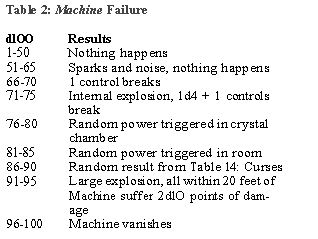
Second, every time an effect is triggered, the operator must make a save vs spell. If the roll is failed, the character’s Intelligence score is increased by 1 while the Wisdom score is reduced by 1. With each failed save, the character’s cranium increases by 10%.
Suggested Means of Destruction:
- The machine is quite delicate and can be destroyed with repeated blows, each ruining 1d4 controls. Each blow has an 80% chance of causing an explosion, dealing 2d12 damage to the attacker.
- Every 100 years, the Machine loses 1d4 of its powers through natural atrophy.
That was kind of disappointing, honestly. Let’s talk about an artifact that actually has abilities. Now Lum’s friend, Leuk-o, had his own artifact, The Mighty Servant of Leuk-o, a jet-black, 9 foot tall fantasy mecha. The interior of the Mighty Servant is configured for two man-sized creatures, while as up to 5 can ride on the top while it’s moving It’s speculated that whoever created the Mighty Servant also built the Machine of Lum the Mad, although the theory probably comes from the intertwined history of the artifacts’ namesake. General Leuk-o was a follower of Lum when he found the artifact. Upon finding the Mighty Servant, Leuk-o decided that taking orders was for sods and split Lum’s domain into civil war. After several battles that ended in a draw, Lum and Leuk-o faced each other artifact v artifact. The aftermath of their clash left Lum’s kingdom a scorched wasteland, and both artifacts lost to time.
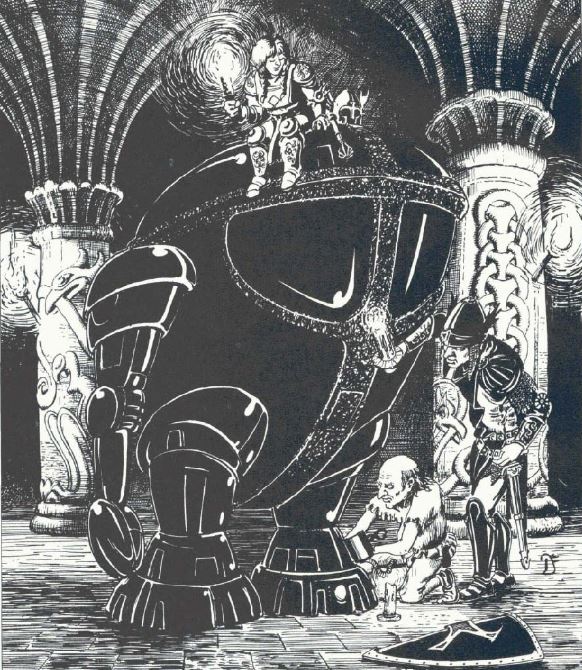
The Mighty Servant of Leuk-o’s powers are written with what I think are rules for large-scale battles, so it makes sense that the book suggests that giving this artifact to an antagonist so the players have to raise an army to stop him or her. While the book says the artifact isn’t something that should be left with players for long because of its curse, it also says that adventures can be made for finding out how to use the Mighty Servant’s powers. So maybe the players ride around it once or twice, and then it just disappears?

The Mighty Servant of Leuk-o has 60 hit points and -6 AC. It can only be struck by +2 weapons or better. Bludgeoning weapons do only 1 point of damage against it, while edged weapons only cause half their normal damage, rounded down. It has 90% Magic Resistance, and is utterly immune to acid, cold, heat, normal fire, vacuum and water. Lightning, electricity and magical fire inflict 20% normal damage, assuming the attack gets through the MR. If damaged, the Mighty Servant regenerates 2 hp/round. Anyone inside the Mighty Servant is fully protected from outside attacks. Given all these defenses, it is possible to destroy the Mighty Servant by reducing its hp to zero.
The interior of the Mighty Servant is akin to a modern cockpit, and anyone trying to use its active powers needs either to consult sages or tomes or experiment through trial and error. At least the DM is told to just abstract this learning process. The Mighty Servant of Leuk-o has a movement of 3, and can only be active for 12 hours at a time. After-which the machine must be inactive for an hour to recharge its energies. The Mighty Servant “strikes as a 10-HD creature” (does that mean it uses the default THAC0? Why not just give the THAC0? Damnit, TSR!). It can attack once a round (or at least that’s my reading) and each blow does 1d6 x 10 points of damage. The Mighty Servant is strong enough to destroy castles. If used as a siege engine, it does the same damage as a screw or ram. If used in a BattleSystem game, its stats are AD d12+d8, AR 4, HD 10, Hits 5, MV 3. For random powers, the Mighty Servant gets 6 Offensive Powers, 6 Major SLP, and 2 Healing Powers that apply to any one creature inside the interior compartment. Using any of these abilities drains one hour of continuous usage.
Major SLP: 24, 7, 50, 46, 65, 99
- 4-7: Cast animate dead 1/day
- 24-26: Cast destruction 1/week
- 44-46: Cast magic jar 1/day
- 47-50: Cast mindshatter 1/week
- 96-100: cast wither 1/week
Offensive Powers: 1, 2, 18, 1, 18, 8
- 1: Cast age creature 1/day
- 2: Cast Bibgy’s crushing hand 1/day
- 8: Cast disintigrate 1/week
- 18: Cast suffocate 1/week
Healing: 20, 19
- 19: Cause all healing spells applied to the user to be doubly effective
- 20: Erase scars and other disfigurements caused by battle (at will)
The Mighty Servant’s curse has both a short- and long-term component. First, every time the operator uses a power, he must make a save vs spell or goes into a battle frenzy for 24 hours. “During that time, the artifact is used in a rampage of destruction to any and all within reach.” Considering that the Mighty Servant has to take an hour break every 12 hours, it seems that might be difficult. Second, the character using the Mighty Servant risks Artifact Transformation. “Those affected by this power gradually have their alignment shifted to chaotic neutral”. That-that’s not what Artifact Transformation is used for

Besides hitting it a lot, there are two other means of destruction suggested
- A self-destruct command phrase. This causes an explosion-no specifics beyond “very big”
- One of the powers of the Machine of Lum the Mad is to destroy the machine. If Lum knew that such a power existed, he never used it.
“It is a purely chaotic artifact. Thus it is a wonderful item to give to player characters.”
Original SA postIt’s been a while, and the start of The Great Modron March review tempted me to put this on hold to review Planes of Law, but I’m committed to finishing this up.

4: “It is a purely chaotic artifact. Thus it is a wonderful item to give to player characters.”
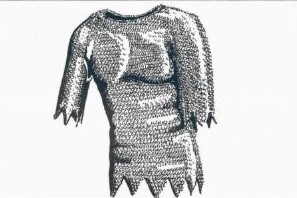
For this update, I’m going to focus on artifacts that a Player Character can use. Or at least ones the book says they can use. The Invulnerable Coat of Arnd is a non-descript chainmail shirt. It’s probably the most straight-forward artifact in this book, both in its background and function. There was an evil wizard named Vitros oppressing a small nation. The priests and craftsman of said nation made a chainmail shirt and prayed for someone to murder-hob the wizard. A wandering priest named Arnd shows up and wearing the coat he kicks Vitros’ shit in. And then he rides off into the sunset. The End. The book suggests giving the coat to a PC so they can do the same. Simple!
The Invulnerable Coat can re-size itself to any humanoid between 3 and 8 feet, an ability that’s since been presumed to be in any magic item. The wearer of the Coat cannot be hit by any physical attack except on a natural 20 and receives a +5 bonus to all saving throws. The armor protects as a ring of fire protection and is immune to acid, cold, and electrical attacks. (The wording is confusing, I think it’s supposed to say that the wearer is immune). A cleric wearing the Coat can utter a special prayer to gain 3 experience levels for 4 days (1/month). This increases includes hit points, attacks, spells and saving throws. The Coat’s curse is that whenever the wearer is in the presence of impoverished or suffering people, there is a 70% chance that the spirit of Arnd will take possession of the wearer to aid the unfortunate. The wearer spends 2d4+1 hours roaming the area, seeking out the poor and aiding them “as a 14th level cleric”, whatever that means. The wearer has no memory of what they did after this period ends.
Suggested Means of Destruction:
- It must be unraveled by a person without conscience
- It must be fed to the father of rust monsters
- A deity of avarice must be forced to wear the coat, whereupon the magic is released violently (roll once on Table II: Cataclysms)
Hey, why don’t we check out that table? Cataclysms work more like Artifact curses than powers because the user has no control over using them. The default range of these effects is a 1 mile diameter centered on the Artifact. So let’s suppose Donald Trump (TOPICAL HUMOR LOL!) tries to squeeze himself into the Coat. As a result...
Table 11: Cataclysms: 12
- 12: Sweep an incendiary cloud through the entire area of effect.
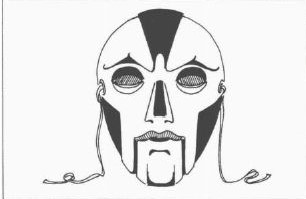
Johydee’s Mask is another artifact that the book says is appropriate to use for low-level parties. The full face mask is made of an unknown opaque material shaded gray. It has a similar background to the Coat of Arnd. A well-organized band of thieves terrorized a frontier region until one day when it was visited by a priestess of a goddess of truth and justice named Johydee. Rather than murderhobo the thieves away, she instead creates the mask with the assistance of a retired illusionist. The mask allowed Johydee take the guise of the band’s leader and infiltrated their ranks. She discovered long-buried divisions amongst the thieves, and brought them back to the surface. As a result the Thieves Band dissolved, and the region was once again at peace.
Aside from giving the mask to the party, the DM can have an adversary use the mask to plot a series of thefts, and “at the end of the adventure the mask can allow the thief to elude the party and finally disappear without a trace.” Yeah, fuck you again, 2nd edition.
The wearer of Johydee’s Mask is immune to all gaze attacks. The PC can assume the guise of any humanoid being, from gnome to hill giant size, by concentrating for one full round. If the PC has seen or heard the subject, the disguise is complete, “including voice, mannerism, clothing, and equipment.” There is a 5% chance per hour that close friends and family of the subject will detect discrepancies. This power can be used once a day, and lasts up to 12 hours. In addition, the Mask has 1 random power from the Movement table and 1from Enchantment/Charm:
Table 27: Movement: 19 Table 21: Enchantment/Charm: 4
- Movement-19: Cast word of recall (1/day)
- Enchantment/Charm-4: Cast charm person (2/day)
The Mask’s curse is that there is a 2% chance per hour spent in impersonation that the wearer comes to believe that the identity of the subject is actually their own. Only a wish can reverse this effect.
Suggested Means of Destruction:
- The Mask must be eaten by a mimic
- It must be worn by one with no mind
- It must be merged with its own reflection.
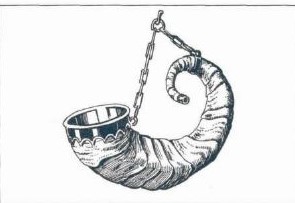
The Horn of Change is one of those artifacts that’s simply a collection of random powers. The book seems to believe this is an appropriate item to give to players because it will “provide many opportunities for role-playing”. In practice the item is a campaign wrecker with no justification for including it. It doesn’t even have an interesting story. Once upon a time a rogue goes gambling, has a huge luck streak, brags about, then OH NO a charismatic stranger comes to the gaming table and the rogue’s luck streak reverses. Finally, the rogue bets the last thing he has-his soul-and the stranger puts the horn against it. The rogue wins, and “after gaining a reputation for wonders,” he vanishes one day without a trace.
When a character picks up the Horn, he is instantly aware of its possibilities (the DM is told to show the player the table in this entry). Every time the horn is blown, the DM rolls on the main table, then rolls on the table referred to.
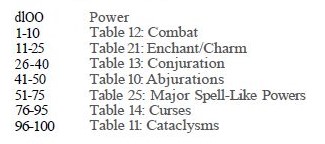
Let’s take a roll from each of these tables:
http://orokos.com/roll/456672
http://orokos.com/roll/456675
- Combat-20: Cast warband quest (1/month)
- Enchant/Charm-13: Cast feeblemind by touch (1/week)
- Conjuration-4: Cast animate object (1/day)
- Abjuration-4: Instantly dismiss an elemental (1/week)
- Major Spell-Like Powers-86: Cast veil 1/week)
- Curses-15: Age the user 1d10 years each time the artifact is used
- Cataclysms-14: Instantly create a permanent magic dead area of effect
Those last two entries are always negatives imposed on the user. So there is a 1-in-4 chance with each use that the Horn fucks the player over. In addition, each day the character owns the Horn there is a cumulative 1% chance that he is seized by gambling fever and must take any honest wager. This lasts until the Horn itself is gambled away.
Suggested Means of Destruction:
- The powers of luck must be gambled with to destroy the Horn
- The gods of justice must be cheated, an ultimate gamble
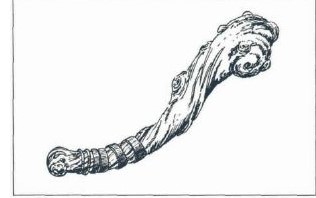
Well that was some bullshit. Let’s get to something more straightforward. The Mace of Cuthbert is a gnarl wooden club. St. Cuthbert is the Judge Dredd of TSR’s list of gods. He travels the countryside in human form testing the faith of his followers. If it is lacking Cuthbert whacks the follower and their faith is restored. In some circumstances, Cuthbert gives the Mace to a follower so that they can whoop ass on his behalf. The Campaign Use segment has some good suggestions. Aside from general murderhoboing the PCs may be tasked with recovering the relic from enemies of the church or perhaps a powerful but corrupt member of the clergy.
The cudgel functions as a +5 mace of disruption. Any intelligent mortal struck by the club becomes an enthusiastic follower of Cuthbert for 1 day, and on a natural 20, the target loses 1 point of intelligence (no save or MR). A cleric of Cuthbert can cast detect undead at will and call upon faith 3/day. 1/day the wielder can cast a modified version of cloak of bravery that gives a +3 save for all types of save and the effect is granted to up to 4 creatures and lasts 8 hours. The Mace’s curse is that the wielder becomes a lawful good follower of Cuthbert and an extreme zealot, trying to convert everyone. In addition “the zealot’s Charisma is reduced to 4 due to obnoxious behavior for as long as the Mace is possessed.” Methinks someone is projecting a bit here.
Suggested Means of Destruction:
- Iuz the Old must be polymorphed into a giant beaver and the Mace fed to him.
- It must be covered by the natural formation of a stalagmite, which then receives a transmute rock to mud spell
- The bronzewood tree that the club came from must be prevented from ever growing
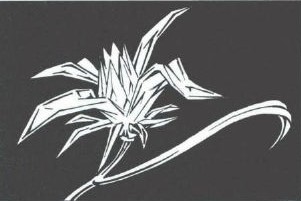
Let’s get one more artifact in. The Jacinth of Inestimable Beauty is a crystalline, fist-sized flower made from orange corundum facets sewn together with strands of gold. The Jacinth was cut and assembled by a dwarf named Jojonek. Jojonek was guided by the gods in crafting the flower, and they gifted him with 4 bottles of floral scented oils. So not only does the artifact look like a flower, but it has the fragrance of a flower. Of course Jojonek took all the credit for making the Jacinth, which the gods weren’t too keen with. So they drove the dwarf insane until he fled his home with the Jacinth. Just another day in Dwarf Fortress
 The book doesn’t offer any complicated campaign ideas, suggesting the flower causing NPCs to act strangely (or charming PCs, because 2nd ed gonna 2nd ed).
The book doesn’t offer any complicated campaign ideas, suggesting the flower causing NPCs to act strangely (or charming PCs, because 2nd ed gonna 2nd ed).Contact with the Jacinth adds 5 points to the user’s Charisma (maximum 21). To use the invoked powers, a PC specifies a floral scent while holding and smelling deeply of the flower. This releases the named scent and the power. If no scent is named or a scent is specified that the flower doesn’t have, a random scent is released. The scents and their powers are:
-
Violet: Charm person (2/day)
Lavender: Suggestion (3/day, cast at 20th level)
Rose: 1 from Major SLP table
Jacinth: 1 from Fate and Fortune table
Fate & Fortune: 4-Permanently imbue the user with all knowledge of the gambling profession. If the user is already proficient in gambling, the ability score improves by 1
The character suffers the effects of chaotic sleep while in possession of the Jacinth. When the ratio of sleeplessness to sleep is 2 to 1 (um isn’t that the human norm?
 ) the PC becomes sluggish and incoherent, taking -1 to all attributes. At 3 to 1, the character becomes paranoid, meaning reaction rolls are required for each encounter with -6 penalties.
) the PC becomes sluggish and incoherent, taking -1 to all attributes. At 3 to 1, the character becomes paranoid, meaning reaction rolls are required for each encounter with -6 penalties.Suggested Means of Destruction
- The Jacinth must be bathed in a mixture of pollen from every kind of blossom.
- It must be consumed by someone with no sense of smell.
Dragonorb Z
Original SA post
5: Dragonorb Z
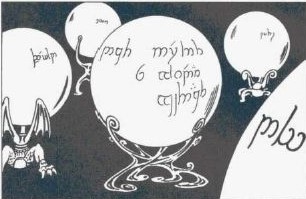
A few of the entries in the Book of Artifacts are very long, encompassing a number of related items. One such entry is the Orbs of Dragonkind. There are twelve such orbs and each is made of the finest crystal. Close inspection shows faint writing in a forgotten language. The orbs vary in size, although the difference is only apparent if they are put next to each other. Each orb comes with a three-armed stand, but the stand is not a part of the artifact. When an orb is used, it glows with an internal fire that matches the color of its dragon type. The Book of Artifact says that the Orbs of Dragonkind in this book are not the same as the ones from the Dragonlance setting, which raises the question of why they just didn’t present those artifacts instead (and it’s not like setting-specific artifacts aren’t included).
The origins of the Orbs of Dragonkind go back to the beginnings of whatever setting they’re in-by including them, a DM is basically making them an important part of their lore. There are three versions of how the Orbs were created - one told by humans, another told by elves, and a third told by dwarves. It’s broadly Tolkien-esque, in that in the before times everything was awesome, with dragons and mortals living together, then something happened that made things suck like they do now, and the orbs being created is part of the reason things suck. As to the specifics of each story, here’s the tl;dr for the three stories:
Human: Jonah becomes the Dovakim
Elf: Seriously, elves are dicks
Dwarf:


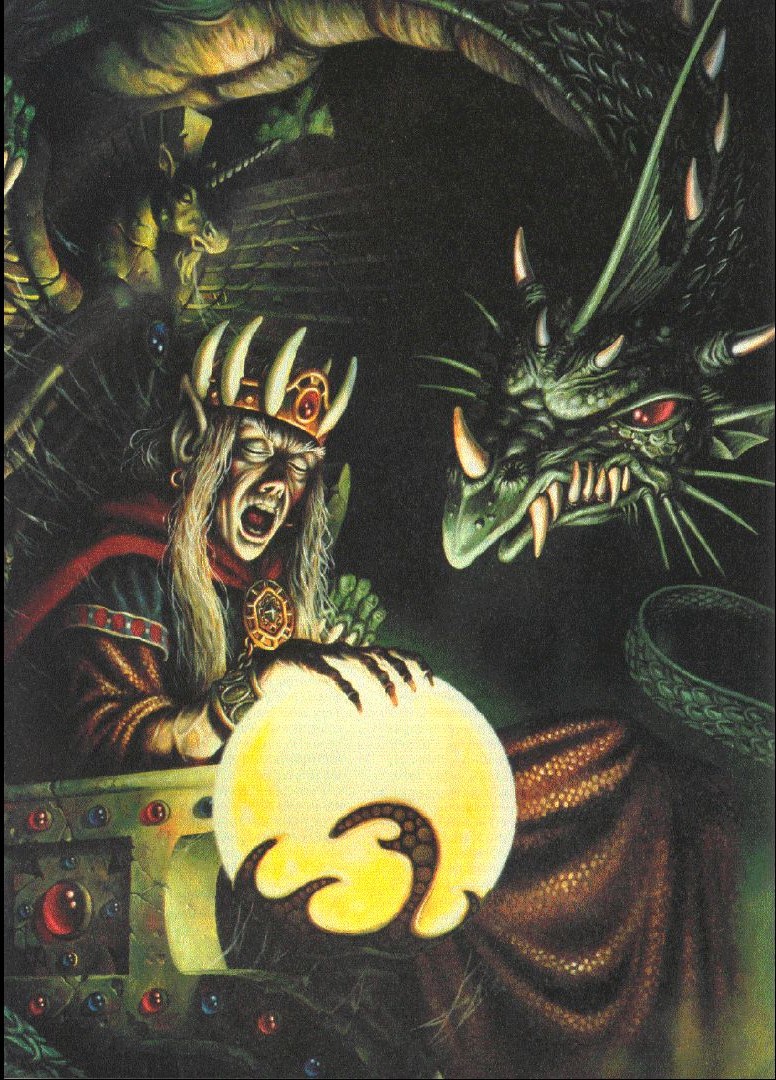
Honestly, I think my summaries make those stories sound more interesting than they actually are, but who cares? All three stories have each Orb holding the essence of a dragon paragon who was uniquely powerful in a way contemporary dragons can’t match. Since their creation the Orbs have surfaced many times throughout the world, bringing both weal and woe. And dragons.
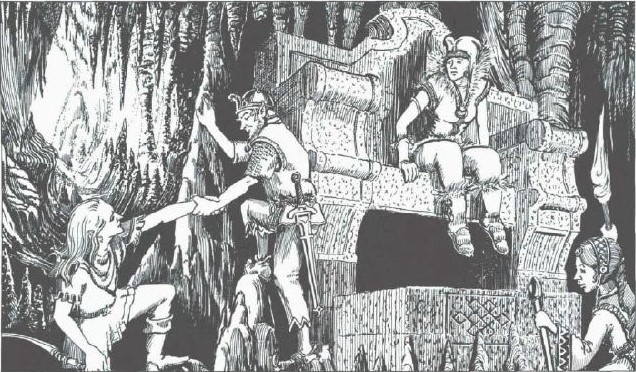
an entirely different artifact is pictured here
The Book of Artifacts has a lot of advice on how to use the Orbs. The first advice is that a given campaign shouldn’t feature all 12 Orbs, and the players should never have all 12 or even half that number in their possession. Second, the dragons within each orb should have a distinct personality, and the book offers suggestions in that department. Finally the orbs are unique in their power, and not just by color. See, in 2nd edition (and most editions besides 4th I believe) dragons came in 12 age category. I assume this was done so a DM could include the game’s titular monster in a campaign without necessarily going through the slog of getting PCs to high level, but that’s not important. What is important is that there’s not only an orb for each species of dragon, but each age group. Which makes no goddamn sense given the history of the orbs, seeing that they were made to imprison the strongest of the ancient dragons. But instead the book assumes that these Orbs are as likely to contain Spike from My Little Pony as they are to hold Ancalagon the Black.
So the campaign arc the book suggests is a major adventure that climaxes with the discovery, use, and/or destruction of one of the Orbs. The existence of the other orbs is just suggested, but only a few should be used in a given adventure. But the book doesn’t ignore the idea of using all 12 orbs in an epic campaign. It does have some of TSR’s allergy to giving players too much power, but I’ll be fair and say that at least it offers solutions to the problem it perceives rather than throw up its hands and declare that campaigns must never include all 12 orbs. In this case, it suggests that the acquisition of each orb should be varied in the obstacles. The book also suggests building an entire campaign world centered around the Orbs being the keystones to the different kingdoms, and it reads like a summary of the D&D movie from 2000. And like many artifacts, the book is pretty insistent on taking it away from the players once it has served its purpose. Whatever, you’re going to have to do better to rile me up in this post-election review, TSR.
Most if not all the powers of each Orb depends on the type and age of the dragon trapped inside, while the dragon’s personality plays into how those powers are called upon. The main variable is the trapped dragon’s HD. Each color has a base HD, and this is modified by the dragon’s age. All 12 Orbs have more than a few powers in common. Anyone within 10 feet of the Orb has the THAC0, AC, and saving throw of the dragon within. (does this override a better value?
 ). These individuals are also immune to breath weapon attacks of dragons of the same color. The trapped dragon is telepathic to any creature within 60 visual range and possesses full awareness of its surrounding, including invisible or concealed creatures and objects. Whether it makes the Orbs owner aware of these is up to the dragon. Each Orb functions as a Crystal Ball to any other Orb, provided the identity of the other Orb’s owner is known. The owner can use the dragon’s breath weapon 3/day, use dragon-fear 3/day, and cast any spell (including special powers) known by the dragon. Finally the owner can use a domination spell on any dragon of matching color. This power is more difficult to resist the older the trapped dragon is. This power can be used 1/round.
). These individuals are also immune to breath weapon attacks of dragons of the same color. The trapped dragon is telepathic to any creature within 60 visual range and possesses full awareness of its surrounding, including invisible or concealed creatures and objects. Whether it makes the Orbs owner aware of these is up to the dragon. Each Orb functions as a Crystal Ball to any other Orb, provided the identity of the other Orb’s owner is known. The owner can use the dragon’s breath weapon 3/day, use dragon-fear 3/day, and cast any spell (including special powers) known by the dragon. Finally the owner can use a domination spell on any dragon of matching color. This power is more difficult to resist the older the trapped dragon is. This power can be used 1/round.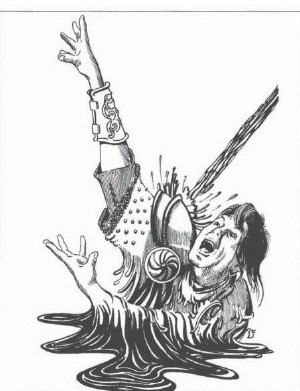
Beyond these powers are the ones unique to each color:
- Black (12 HD): Create an acid storm with a radius of 100 yards that lasts HD rounds. (1/month)
- Blue (14 HD): Cast a modified chain lightning that hits up to HD targets. Damage is not reduced from arcing. (1/day)
- Brass (12 HD): Trigger circle of sunmotes. (1/month)
- Bronze (14 HD): Cast imago interrogation (1/month), reminder that it can’t be used to learn about other artifacts because.
- Cloud (14 HD): Cast storm of vengeance (1/month) with a 1 round cast time
- Copper (13 HD): Cast a modified mass suggestion. Anyone in a 30 foot radius of the orb with fewer HD or levels than the dragon are affected, no save. (1/week)
- Gold (16 HD): Summon 1d6+HD dragons of any color (DM’s determination). These dragons are the same age as the one in the Orb. Once summoned they serve the Orb’s owner for 3d6 days. (1/year)
- Green (13 HD): This power only works in forests. Shoots a ray out 100 yards that turns HD number of trees into uncontrolled Shambling Mounds. The mounds last 24 hours or until slain. (1/month)
- Red (15 HD): Create a volcano. The volcano erupts 2d12 after the power is activated and forms over a process of weeks. “The radius is destruction is equal to the Hit Dice of the of the trapped Red Dragon.” No unit of measurement is given. Magic and holy buildings are allowed a saving throw, but everything else is ruined. (1/year)
- Shadow (12 HD): An area with a diameter of HDx100 yards is transported to the Plane of Shadow for 1 year, while a corresponding part of that demi-plane is put in its place (1/year)
- Silver (15 HD): Resurrect 2d10 x 10 bodies in a 100 yard area. This power can distinguish friend from foe. PCs still have to make resurrection checks, but for some reason low level NPCs and common soldier automatically come back. (1/year)
- White (11 HD): All allies within 100 yards are seized by war frenzy: 2 extra hit dice, +2 to hit, damage and saving throws, and immune to fear, charm and all illusions. (1/month)
Next a DM determines the age of the Orb’s dragon. Besides modifying the HD value, ages also have an assortment of random powers. Generally the older the dragon the better the selection, although some random tables get phased out from the older dragons.
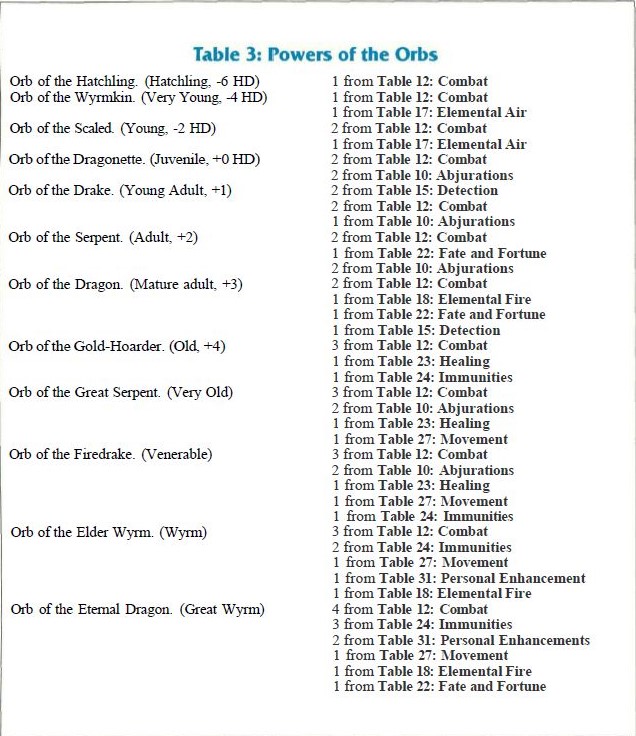
Here’s a sampling of random powers you might find associated with with an Orb: Roll Link
4 Combat: 18, 17, 10, 14
- 18: Cast Tenser’s Transformation on the user (1/day)
- 17: Imbue the user with all benefits of weapon specialization
- 10: Imbue the user with skills with the weapon, regardless of class
- 14: Imbue the user with skills with two weapons at no penalty
- 9: Imbue the user with immunity to all magical mental attacks. The character is still vulnerable to psionic attacks.
- 17: Imbue the user with immunity to illusions, always revealing these as shadowy forms. This power does not reveal anything where the physical form has actually been changed, such as polymorphed objects or creatures.
- 17: Permanently imbue the user with the ability to use speak with animals at will
- 16: Permanently imbue the user with the ability to use speak with monsters at will
- 20: Have turn wood constantly in effect while the artifact is in hand
- 11: Cast knock (3/day)
- 2: Imbue the user with all benefits of the appraisal proficiency
- 13: Cast emotion read (3/day)
- Movement-17: Cast water walk (5/day)
- Elemental Fire-1: Cast chariot of Sustarre (1/week)
- Fate & Fortune-13: Always grant fair sailing winds to any ship or wind-powered vessel the user is on
- Healing-15:Cast neutralize poison (3/day)
- Elemental Air-20: Send messages in a fashion similar to a whispering wind. The user need only know the name of the recipient before whispering a message to the sky. The user's voice will reach its target within 24 hours, if that person is on the same plane (at will).
The final component to each Orb is its personality. This is important for two things. First is the effect of the curse. Second is that the personality is important to actually using the artifact. The dragon in each Orb has to be convinced to use its power. Methods of convincing listed by the book are cajoling, promising, threatening, or bribing. How any of these can be applied to an ancient immortal dragon trapped inside a near-invulnerable artifact isn’t addressed, but there you go. While a DM can create his own characters, the book gives 12 samples. The 12 personalities suggested are Naive, Sullen, Tricky, Patient, Impatient, Curious, Bored, Hate-filled, Despairing, Stoic, Mad and Desperate. Any three of Color, Age or Personality can be combined together in any way, without regard to the standard behavior of a dragon species. So a Hate-Filled Bronze Hatchling is totally legitimate, as is a Naive Cloud Great Wyrm.
The Orbs have the twin curses of Artifact Possession and Artifact Transformation. Over time the owner is possessed by the dragon trapped inside while being transformed into the dragon’s original form. When the process is complete, the trapped dragon is freed while the owner’s spirit is lost to the void. Presumably this would destroy the Orb, but this isn’t indicated in the suggested means of destruction. In fact it suggests that the artifact is only destroyed if the user is willingly possessed. Also the freed dragon is apparently just a contemporary dragon and not some ancient super-dragon, which the history seems to imply.
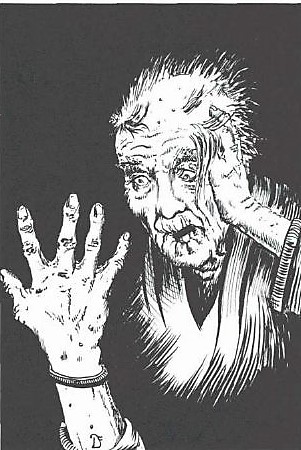
Suggested Means of Destruction
- The dragon can be released by sacrificing oneself with a magic jar spell, to be trapped within the Orb.
- All 12 must be ground simultaneously under the Great Millstone of the Gods.
- The original makers of the Orbs must be found at the beginning of time, and the secret of the Orb’s destruction must be learned from them.
“The rest of the group will have to find a way to rectify this, while the DM plays the character for a while.”
Original SA post
6: “The rest of the group will have to find a way to rectify this, while the DM plays the character for a while.”
For this update, I’m going to focus on artifacts that probably should not be given to players. This is just from my review of the artifact’s ability, we’ll see if the book agrees.
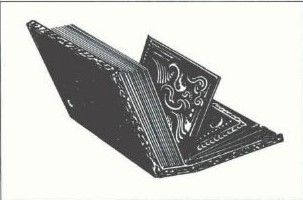
The Codex of Infinite Planes is a massive tome that takes at least two strong men to lift. The covers are made of pure obsidian and the pages-illuminated with strange writings in forgotten languages-are made of lead hammered so thin that they flex like paper. While it has a finite mass and volume, the codex has infinite pages, as there is always one more page. We’ll come back to that point when we discuss the powers.
The Codex’s history is pretty vague. No one knows who made it, although it’s also known as Yagrax’s Tome. The first mention of the codex is of a tyrannical wizard-priest that used the codex to control an empire until the artifact backfired and destroyed both. More recently, an archmage named Tzunk found the Codex before disappearing shortly thereafter. The book suggests that DMs can use the book to introduce high level PCs to adventuring on the Outer Planes (this came out before Planescape), but that it shouldn’t be left with them for long. Alternatively, PCs may need to use the book to halt some manner of fuckery a wizard brought about.
The powers of the Codex are triggered by reading the right page. The Codex’s base power is that it can open a portal to any plane, demiplane, or prime material world. However, the codex does not have an index or table of contents. So how the codex can be used is a mystery. Maybe the PCs need to find the evil wizard-priest’s research notes, but the book doesn’t say. The only other known power is to summon a greater fiend to serve for 24 hours (1/month). For random powers, the Codex gets 4 from Major-SLPs and 4 from Minor-SLPs.
Table 25-Major Spell-like Powers: 73, 15, 71, 50
- 14-17: Cast cause serious wound (3/day)
- 16: Cast contagion (3/day)
- 32-33: Cast enlarge (3/day)
- 42-43: Cast flame arrow (5/day)
- 78-79: Cast sleep (5/day)
The artifact’s curse is that every page read has a cumulative 1% chance of triggering “an awful fate”. What this entails is up to the DM, but the entry gives suggestions like irreversible madness, the arrival of a major Tanar’ri, 10-mile radius cloud of deadly poison (no save), “or worse”.
Suggested Means of Destruction
- It cannot be destroyed, only safely hidden where it can cause no harm
- Every page of its infinite pages must be read
- One page of the book opens a portal upon the book itself, wiping it out from existence.
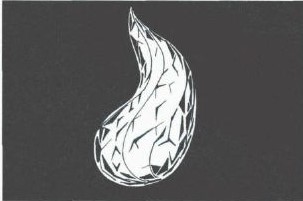
The Crystal of the Ebon Flame is a flame-shaped diamond that, when touched gives off “rays of light and darkness” as though a fire was hidden within the gem. It’s origins are nebulous. Over the centuries, cults have formed around the Crystal, but these eventually disperse when the locals get sick of their shit and drive them into hiding. The campaign suggestions revolve around this cult, though we don’t get any information on this organization.
The owner of the Crystal of the Ebon Flame can cast shades 2/day. The Crystal also gets 4 powers from the Minor SLP table and 1 from the Major SLP table. Each of these powers is activated by gazing into the crystal for 1d4 rounds. The Crystal’s curse is that everyone within 30 feet of the activated Crystal, including the owner, must make a save vs spell or be affected by the spell fire charm. Characters charmed this way have to make a second saving throw, and if failed they are put under the effect of a permanent suggestion spell that attempts to convince them to become a devoted follower of the Flame’s cult. The wording on the curse is pretty bizarre, because it’s a spell effect and yet by using the word “attempt” it implies that even after two failed saves a character can just say “Nah, I’m good
 “ Maybe it’s trying to be like the parts of Lord of the Ring where the Ring is a persistent temptation but never actually takes a person’s free will until they purposefully give in?
“ Maybe it’s trying to be like the parts of Lord of the Ring where the Ring is a persistent temptation but never actually takes a person’s free will until they purposefully give in?  Setting that aside, the fact that this check has to be made with every use makes it unusable by players.
Setting that aside, the fact that this check has to be made with every use makes it unusable by players.Table 25-Major Spell-like Powers: 70
Table 26-Minor Spell-like Powers: 24, 73, 64, 4
- 4-5: Cast bless (7/day)
- 23-24: Cast create food and water (5/day)
- 64: Cast phantasmal killer (3/day)
Suggested Means of Destruction:
- It must be melted in the core of the Earth
- It must be shattered on the Para-elemental Plane of Ice
- It must be crushed beneath Thor’s hammer
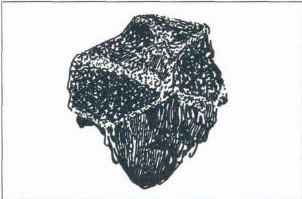
The Death Rock is a vaguely heart shaped black rock that pulsates and exudes a palpable aura of evil. The Death Rock’s origin is that it was torn from the heart of a great salamander that was being worshipped by an evil cult. I remember when I first read this book I only knew about salamanders from reading a “Big Book of Reptiles” in grade school, so I was pretty confused about this story. The book suggests that the DM should use the rock to tempt his players. I’d blast the tone of adversarial DMing, but that’s been done in other F&F entries. Instead, I’ll comment on how the Death Rock misses the mark on how to tempt someone into doing something they normally wouldn’t do.
The Death Rock’s power is that it lets its owner cast necromantic spells as a necromancer of his or her level. The player gets the better of his own class or a wizard class, which basically means some Saving Throws get to be better. If a player is already a wizard, then his or her spell slots are doubled, but these extra spells must be from the necromancy school. The curse is that to activate and maintain the artifact’s powers, the character’s closest companion must be claimed each week as a zombie slave. If this is not done, the artifact vanishes, never to be seen again. The problem is that there is no gradual build up on what a PC must sacrifice to have this power, no free hit to get them hooked. Instead it goes straight to “kill another party member”, and no group with any cohesiveness is going to fall for this. Any group that would is either doing it on a lark or wasn’t going to last past the first session anyway.
Suggested Means of Destruction
- It must be burned in the Flames of Pure Truth
- It must be used to slay a god of death
- It must be given to a man who was never alive
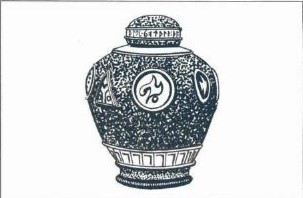
The Iron Flask of Tuerny the Merciless is a heavy urn that’s small enough to be carried in the palm of a hand. The history starts off by telling us that “In all of human history only one man has epitomized the essence of pure evil, Tuerny the Merciless”. Which explains why he’s never mentioned again in D&D products. Tuerny was basically a Villain-of-the-Week that’s hoisted by his own petards in the end. In his case, he devised the Iron Flask as a way of controlling a greater Tanar’ri, but in the end the Tanar’ri turns against Tuerny and drags him to the Abyss. A chain of events that surprised no one. The campaign suggestions for the Iron Flask is to keep it away from others or convince others not to use it.
The Iron Flask contains one of the following Tanar’ri: a nabassu, glabrezu, marilith or nalfeshnee. Amusingly, the 2nd Edition Monstrous Manual that I had only had the stats for mariliths. But thankfully we have the Planescape Monster Compendium to fill in the gaps. Once per day, it can can be released to wreak havoc for up to 8 hours. If it’s killed the Tanar’ri instantly returns to the flask. The Iron Flask also has 2 random powers from the Offensive Powers table. The Iron Flask’s curse has a cumulative 5% chance of triggering each time the flask is used, or if the Tanar’ri is released but isn’t told to kill anyone. When triggered The Tanar’ri turns the user into a dretch and drags him back to the Abyss. And because that wasn’t enough the Iron Flask causes artifact transformation that turns the owner Chaotic Evil and instilling the desire to conquer and destroy everything (alright, I guess transformation can change personality too, I’ll stop harping on it).
Table 28-Offensive Powers: 2, 15
- 15: Cast power word: stun (1/day)
Suggested Means of Destruction
- The user must imprison 99 other greater tanar’ri in the Flask
- It must be filled with the tears of 1,000 orphaned children, which melts it
- The Flask must be filled with earth from every battlefield Tuerny fought on
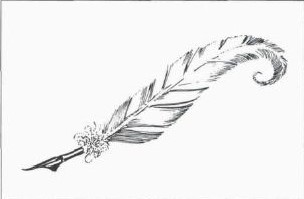
Now we get to the dumbest artifact in this book: Kuroth’s Quill. The quill is a white feather with a gold nib. The history of the artifact starts “during the Age of Veth beyond the Wasted Lands” with an apprentice mage named Baalice who accidentally killed his friend Julian and then spent his entire life (and then undeath) trying to find a way to undo his fuck-up. So being a lich, he creates a quill that casts unlimited wishes, and this works out as well as you might expect. Eventually Baalice realizes he’s just making shit worse and decides to destroy it. Before he can, a thief named Kuroth breaks into his tower and steals the quill. Kuroth figures out the quill’s power, so he rewrites reality so that Baalice believes the quill to be lost. Then a bunch of irrelevant stuff happens that’s supposed to give examples of the Quill’s powers, I suppose. To the book’s credit it at least realizes that giving players unlimited wishes is a bad idea, but doesn’t take it a step further and conclude “this artifact shouldn’t exist, like, at all”.
So Kuroth’s Quill casts whatever it writes down as a wish. This ability cannot be used more frequently than once every 12 hours (6/week), which contradicts how it’s used in the history section, but whatever. This is the 2nd Edition version of the spell when DM fuckery was the most encouraged.
quote:
"I wish for a staff of the magi”
"Well the staff appears in front of you, along with the evil level 25th mage holding it. Roll for initiative.”
Suggested Means of Destruction
- The words “Kuroth’s Quill was never made” must be written
on a chalkboardwith the Quill 100,000 times
- The lich Baalice must be located, his memory of the pen restored, and it must be returned to him
- The Quill must be taken back in time and given to the apprentice Julian at the moment of this death
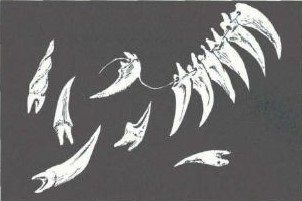
The last artifact for this update are the Teeth of Dalhvar-Nar. This is a set of 32 red dragon teeth: four 6-inch incisors, two 18-inch upper fangs, two 12-inch lower fangs, four 8-inch canines, eight 6-inch canines, four 4-inch bicuspids, and eight 2-inch molars. The Teeth were once a part of an ancient red dragon named Incendrax who was tearing shit up until 13 archmages tracked the dragon down and the two sides blew the fuck out of each other, leaving only Incendrax’s teeth behind. The teeth were eventually found by a cleric named Dalhvar-Nar. Dalhvar-Nar discovered that by dropping a teeth into the ground, it would summon a monster that followed his commands. Dalhvar-Nar eventually did the whole Gollum act, if Gollum was instead a dragon otherkin. The book is pretty clear on this being an NPC artifact “unless the DM wants an anti-social, treasure-hungry, miserly PC wreaking havoc upon the entire campaign”. I’m beginning to think I should have done a passive aggressive advice counter for this review, but I’m too lazy to go back and check my previous entries.
A character holding any of the Teeth is able to detect the exact number and type of all gems and precious metals within 60 feet. Having any teeth allows the character to speak the language of red dragons and “the tongue common to all evil dragons.” Possessing any of the teeth grants a character immunity to all forms of fire. The invoked powers are tied to the specific teeth. To activate a non-molar tooth it must be thrust point first into the ground. The molars are activated by physically planting it in a hole 2 inches or deeper. Both can only be used on soil (clay, dirt, sand, etc). The non-molars summon a monster(s) 1d4 rounds after being dropped. The monster(s) serve the user for 30 rounds as Per the monster summoning I. After use, these teeth return to the set of teeth after 1d2+1 days. The molars take 1d4+1 rounds to bury and cover, after which they imbue the character with a spell-like ability. It’s unclear whether this is a permanent ability or a one-time use.
The monster summoned depends on the type and size of the tooth. The 18-inch upper fangs each summon one 7-HD remohaz or three 15-HD fire giants; the 12-inch lower fangs each summon three 7-HD wyverns or four eight-headed 6-HD hydras; the 8-inch canines each summon six 4-HD fire toads; the 6-inch canines each summon 1d10 2-HD lizard men; and the 4-inch bicuspids each create a 60-foot diameter wall of fire 20 feet high and lasting 20 rounds. For the molars, the DM is supposed to roll a 1d8 and consult the following table:
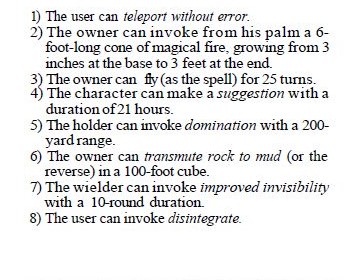
The Teeth’s curse is pretty detailed. The owner immediately becomes chaotic evil and cannot bear to be separated from the Teeth for a moment. Over the course of five weeks, the owner takes on the behavior of an ancient red dragon, including going out to live in a mountain cave, “controlling” swathes of territory, and feuding with gold dragons. Dragon dildo is optional, I assume
 . If this character can be kept away from the teeth, he returns to normal after 1d4+2 weeks. It says that the character loses all his dragon traits as he recovers, even though the Artifact doesn’t actually turn its owner into a dragon or draconic humanoid.
. If this character can be kept away from the teeth, he returns to normal after 1d4+2 weeks. It says that the character loses all his dragon traits as he recovers, even though the Artifact doesn’t actually turn its owner into a dragon or draconic humanoid.Suggested Means of Destruction
- Allow the Teeth to soak in 32 doses of sweet water for 1,000 years, whereupon they will rot away
- Pull all the teeth of a conscious ancient red dragon and replace them with the artifacts without explaining what you are doing.
- Bathe the Teeth in the breath of 32 different types of dragons within 32 days.
Sing a Song for the Pianoman
Original SA post
7: Sing a Song for the Pianoman
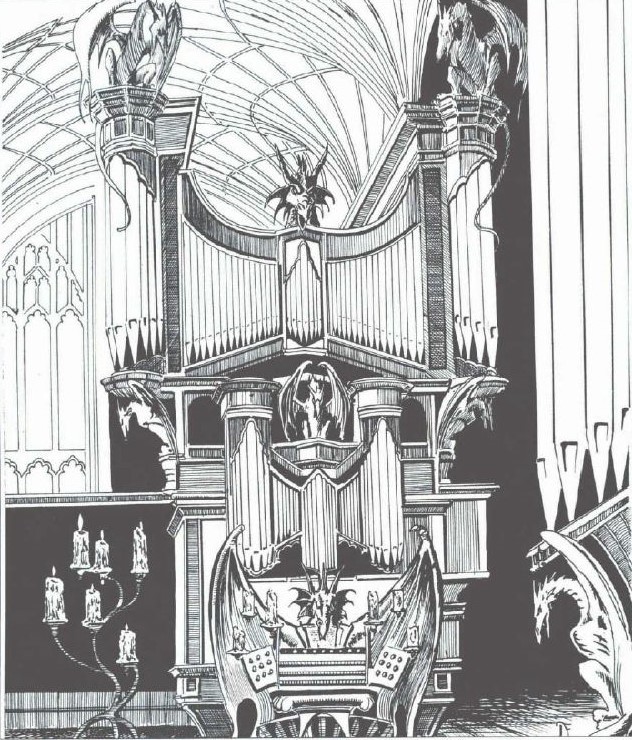
There’s one more artifact that I want to cover before covering magic item creation and then sealing this book in a trap-filled tomb to be forgotten. It’s Heward’s Mystical Organ, another artifact that can trace its origins to Mystical Energies. Like Lum’s Machine, the Organ is an immobile artifact that’s always housed in a cathedral-like building, “not necessarily the same one each time.” The cabinet of this pipe organ has three sets of keys-one of ivory and obsidian, one of jade and lapis, and the third of steel and brass. Each set of keys has nine ivory stops, or 27 in total. Nine rosewood petals complete the cabinet. The organ’s pipes are made of silver and gold, with the tallest reaching almost three stories in height.
Heward was the Patron of Bards, who lived during the ascendancy of humans as the elves faded to the background. Early humans apparently weren’t interested in music, so Heward set out to change that by building a magic organ. The Organ was wildly successful and made everything wonderful, so of course a few deities decided to fuck things up. These gods convinced the mice of Heward’s hall to gnaw on the Organ’s pipes. The next time Heward played the organ it gave harpies and sirens their special abilities. Heward was of course pissed, and so he played one last song to curse the mice into being lowly and meek. And then Heward and his Organ disappeared.
The suggested campaign use for the Organ is very similar to the Machine of Lum the Mad-a party needs the Organ to produce a certain effect, they need to discover the musical sheet, then they have to find the Organ itself, and play the tune. The major difference is that by the artifact’s nature, this artifact works best with a Bard in the part, a class that a PC had a miniscule chance of rolling the requirements for in 2nd edition if they used method 1 of rolling attributes.
Like the Machine, the description of the Organ’s powers is more focused on how to use it than what it can do. There are at least 23 powers of the Organ, each requiring a separate song. No, these powers aren’t actually detailed, but at least the suggested random power tables are provided. To use a power, not only must the song be played flawlessly (an unmodified proficiency check) but the stops must be set appropriately. There are 27 stops, labeled A to Z with the last one marked “!”. Stops can be set from 1 to 8, with 1 being the the default. The ! stop is especially important, as setting it incorrectly automatically triggers the curse. Otherwise, if any of the other stops are incorrect or the proficiency check is failed, the DM needs to roll a d10. On a 1-7, nothing happens, on an 8-9 the artifact curse is triggered, and on a 10 there is a random effect.
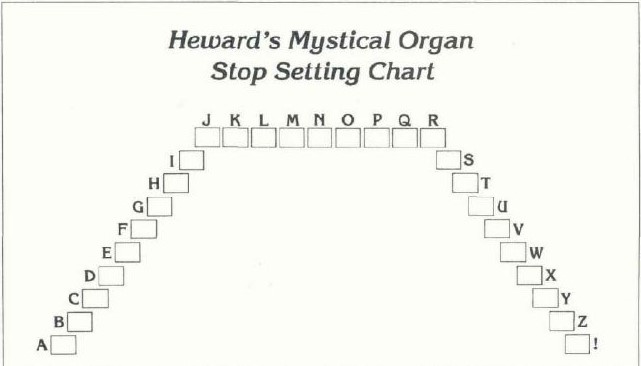
These are the suggested tables for a DM to select the Organ’s powers, but the DM can always come up with his or her own. In fact, a lot of the powers that can come from these result are pretty lackluster for the effort involved, so a DM is better off making his own.
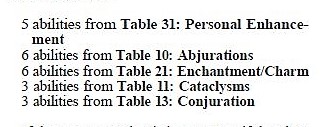
Personal Enhancements: 16, 8, 12, 11, 16
- 8: Regenerate 2 of the user’s hit points per turn
- 11: Cast lasting breath at will
- 12: Provide the user with a permanent +1 bonus to saving throw rolls
- 3: Cast banishment by touch (1/week)
- 5: Cast dismissal upon any planar creature by touch (1/week)
- 6: Cast dispel evil/dispel good (1/day)
- 12: Cast lower resistance (7/day)
- 16: Have repel insects in a 10’ radius constantly in effect while the artifact is in hand
- 3: Cast charm monster (1/day)
- 7: Cast command (7/day)
- 11: Cast emotion (1/day)
- 15: Cast geas by touch. The mission must relate to the goals of the artifact, if any (1/month)
- 17: Cast hypnotism (1/day)
- 20: Cast suggestion (3/day)
- 9: Strike the area of effect with an earthquake spell
- 10: Rain a fire storm down upon the area of effect for 2d6 rounds
- 11: Flood the entire area of effect, destroying buildings and fields. All living creatures unable to fly risk drowning in the rushing water. The water recedes to safe levels in 1d6 hours but remain covering land for 2d20 days.
- 5: Cast call lightning (1/week)
- 15: Summon an invisible stalker (1/week)
- 17: Inscribe a symbol of the user’s choice (1/week)
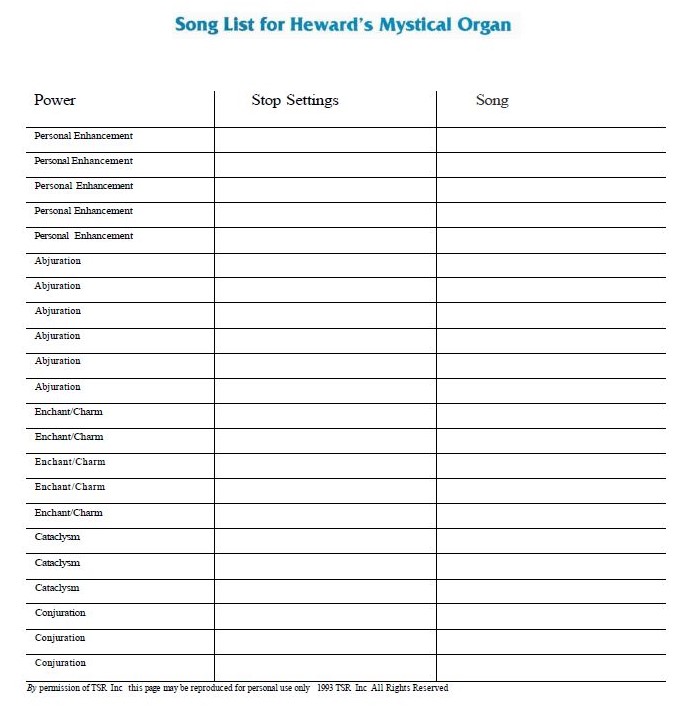
I guess you’re expected to make a song for every power, even if you never plan to use them
If the curse is triggered from playing poorly, then all those within the hall containing the Organ must save vs death at -4. Those who fail go mad forever, unable to tolerate any sound but unable to bear silence either. They lose all class abilities “and are controlled by the referee”. This madness can only be cured with wish. There’s also a risk that a character play the Organ too well. If the organist rolls a 1 or less on the proficiency check, at the end of the song he or she is instantly struck by melancholia, knowing their performance will never likely be matched. Anyone listening must make a Wisdom check or come to the same conclusion. Stricken characters have no motivation to do anything and will waste away. No word on whether this effect can be reversed.
As for the songs themselves, the DM is encouraged to make their own list of tunes based on their own tastes in musics, and it’s suggested to play the tune “on a stereo” at the climactic performance. That’s my favorite part of this artifact, and I could see myself including it not just in a D&D campaign, but any roleplaying game where a world-changing Organ is plausible. At the very least it would rank up there with the greatest effort taken to Rickroll a group of people.

Suggested Means of Destruction
- The King of Mice must be convinced to lead his people in an attack on the Organ, for only they can destroy the instrument’s inner workings
- The worst composer in the entire world must be found to play the instrument. The cacophony that results causes such a titanic explosion that the Organ, its hall, and the surrounding area for a half-mile are destroyed
- The Organ must be burned in a fire kindled with a copy of every work that Heward ever composed.
(Arcane) Arts and Crafts
Original SA post
8: (Arcane) Arts and Crafts
I’ll be honest with this thread-I’m not having fun reviewing every artifact. It’s too much of a slog, and a lot of them are less interesting than the writers believe. Rather than just abandon this review, though, I’m going to skip ahead to the part I wanted to share the most, the section on how players can create magical items. And then I’ll abandon it.
One thing to keep in mind as I review this portion of the book, these are rules for creating standard magical items, not for making artifacts like the book has been describing up to this point.
We begin rather abruptly-like someone forgot to include an opening paragraph-on why a spellcaster would want to create a magical items. Fame, outfitting friends, paying off nobles, and riches are some example. The last reason gets a discouraging finger-wag, partly because 2nd edition was deathly afraid of players getting too much gold, and partly because even without the expanded rules, making magic items has a terrible ROI, especially if the effect is permanent. That’s because permanent magic items required the permanence spell to make, which in 2nd edition reduced the caster’s CON by 1.
Before a wizard or priest can start making magic items, he or she needs to meet the minimum level requirements. Wizards can start making scrolls at level 9, and priests can write them beginning at level 7. Both class-groups can start making potions at level 9, and all other magic items at level 11. A specific magic item can have a much higher level requirement depending on the spells needed to create it. More on that later.
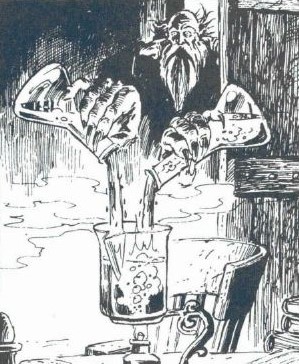
This will end well
Once the minimum level has been achieved, a spellcaster needs a place to work. For wizard classes (mages and the various school specialists), this requires building a laboratory. Priest classes (cleric, druid, and whatever specialty priest class you had the supplement for) needed to sanctify an altar to make magic items. Laboratories are a combination of workshop, alchemist study and library, and making magic items requires the wizard to actually craft the object or be able to bring in the specialist. Fully outfitted wizard labs cost 5,000gp to equip and have an annual upkeep of 500gp. A priest, needs a specific site to make an altar depending on his or her deity’s profile. Preparing an altar for making items requires less gold (2000gp one time) but needs a greater time investment (weeks of prayer plus a service to the deity)
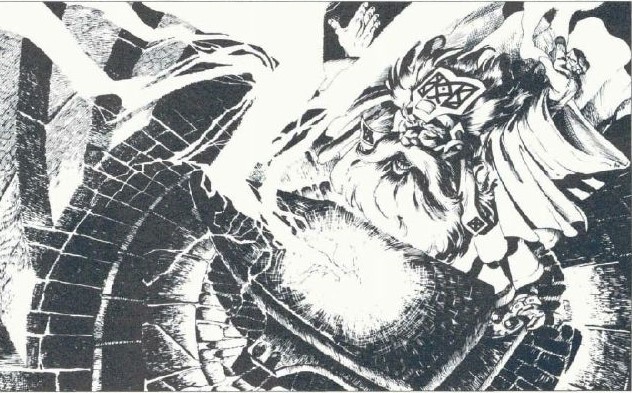
Of course, a player needs the DM’s okay before he or she can start making magic items. This rule is meant to be a case-by-case basis, but because of how this chapter is laid out, my first read was that a wizard or priest could go through all the trouble of setting up a place to make magic items and only now can see if the DM even wants this to be a part of his or her campaign. At least the book advises the DM try to accommodate the player’s goal. Part of the decision of whether an item can be crafted is if it is a standard item, semistandard item, or nonstandard item. This will affect the overall difficulty of making the item. A standard magical item is anything out of the Dungeon Master’s Guide or the Tome of Magic. This includes slight variations on listed item. The book’s example is a ring of magic missiles that otherwise functions as the same-said wand. I could see a way to exploit the change in item slot allocation, but that works on the assumption that magic item creation is worthwhile. Nonstandard items are anything a player makes up, or a major variation on an existing magic item (like a wand of frost that absorbs spell charges). It can also include ‘seldom-discovered’ magic items if the DM so chooses. Finally, semistandard magic items are ones that are significantly modified from a base item, but not enough to be a major modification. The distinction is vague, and if I had to house rule this, I’d just say all modifications of listed magic items are semistandard.
Now the DM has to determine the difficulty rating for a magical item. The difficulty rating is used to derive the time it takes to create a magic item, how much it will cost to make it, and the chance of successfully completing the item. A higher difficulty means longer creation time, higher cost, and greater chance of messing up. Along with whether an item is standard or nonstandard, the difficulty rating is determined by the number of usages it’ll have, the number of spells needed to create it, and the exotic materials and processes that have to be included in the manufacturing of the item. In a remarkable display of page management, these three steps are first described, and then the steps are repeated with the actual rules for calculating them.
Step one in calculating the difficulty is for the DM to determine what spells are needed to create the item. If the item is rechargeable, then it’s recommended to create the item with just one charge and then recharge it after creating it. The number of spells required is then added to the usage rating, which is provided in this table:

If an item is multiple use, then the two types are added together. Step three is to take the current sum and apply the non or semi modification. The difficulty is multiplied by 2 if the item is nonstandard. If it is semistandard, than it is either multiplied by 2 or has 10 added to the total, whichever is lower. Step four is to determine the special processes needed to make the item. The current value is divided by 10, rounding up. That gets you the number of processes needed, and this is also added to the difficulty rating. This addition can change the number of materials/processes required (say if the difficulty is bumped from 19 to 21), and this also has to be added to the difficulty (now 22).
Everybody got that?
Oh and even though the book hasn’t explained what a player needs to do to determine if he succeeds in creating an item yet, it now tells us that specialist wizards get a +5 to their checks if the spells used came from their school.
In addition to special processes, a magic item needs to have special materials to create. The book suggests “as a guideline” requiring one special material for every five points of final difficulty, rounded up. The book recommends that the materials and processes should be thematically related to what the spellcaster is trying to create. The cost of these materials should be 100-1,000 gp times the final difficulty. The books suggests that getting the special materials should be an adventure in and of itself, and may even be inherently impossible without clever thinking on the player’s part. The book also recommends making some required materials perishable, because fuck you I suppose. Basically there’s a page’s worth of writing dedicated to lecturing the DM on making magic item creation as inconvenient to the players as possible. I won’t rewrite this section or even summarize it, because it’s endemic of the attitude of early 2nd edition that if you let players do anything easily You’re Doing It Wrongtm. I’m just going to say that yes, it does draw on an understanding of medieval life that’s probably flawed at least. And yes, it completely ignores the implications of how a setting with magic and monsters and groups of dangerous murderhobos would be different.
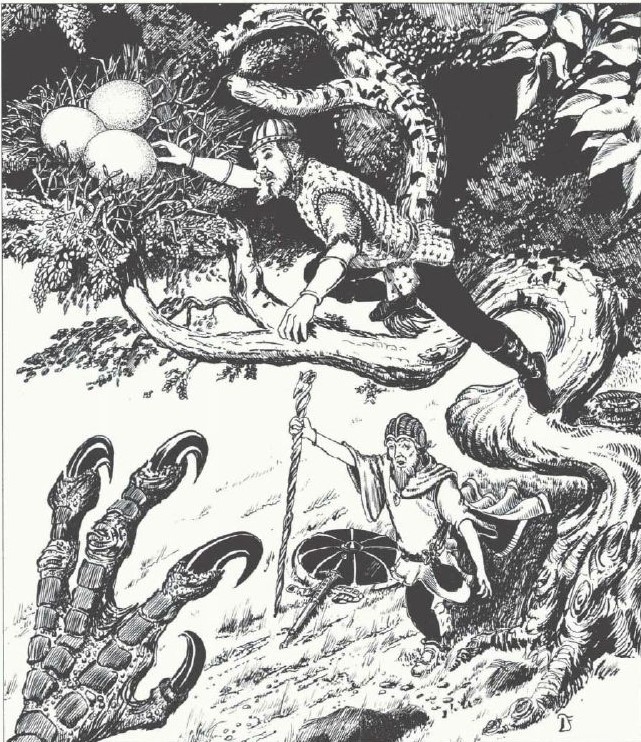
At least the art is cool
There’s one more problem with these instructions, and that is that there’s really no guidance on what actual spells are needed to create a magic item. We know that any magic item besides scrolls and potions requires at least enchant an item, and any with permanent functionality also requires the permanence spell, which in 2nd edition required the caster to permanently lose 1 CON. Those are the spells for a wizard class-I honestly don’t remember if priest classes get these spells too. As for what other spells are required, we only have the few examples from the book. While it wouldn’t be reasonable to expect a book to go over every item, there should have at least been an indication of what is required to give weapons and armor base magical bonuses.
With the difficulty rating now set, the DM now rolls secretly whether the character succeeds or fails to create the item. Every type of magic item has a base chance of successfully creating, and this is adjusted by adding the character’s level and subtracting the difficulty value. There may be other adjustments that apply only to specific items. If the DM rolls under or equal to the percentage chance, then the item is successfully created. If the DM rolls over the percentage but below 96, then the character fails to create the item and is left only with a pile of useless scrap that cannot be salvaged into anything useful. If the DM rolls 96 or above, then the character has unwittingly created a cursed magic item. Whether this critical failure would override a success chance that goes above 95 is unclear.
Item Particulars
Scrolls: There are three types of scrolls in 2nd edition: single-spell scrolls, multi-spell scrolls, and protection scrolls. Rather than determining how many spells the scroll will have beforehand, the character has to roll 1d6 at the time of creation. Scrolls have three components: quill, sheet, and ink. How exotic these need to be depend on the difficulty, and this depends on the difficulty value. The sheet is the most ordinary component. A character needs to use a new quill for each spell being inscribed. The ink is brewed in a single batches, and each batch lasts for two weeks. It takes one day per spell level to inscribe a spell, or six days to make a protection scroll. The base chance of scribing a scroll is 80%. If the scroll doesn’t require a special sheet, there is a 5% bonus for using paper, and a 5% penalty for using papyrus. If the spell holds multiple spells, than a roll has to be made for each spell. If a roll fails, then no more spells can be inscribed.
[pic: scroll table]
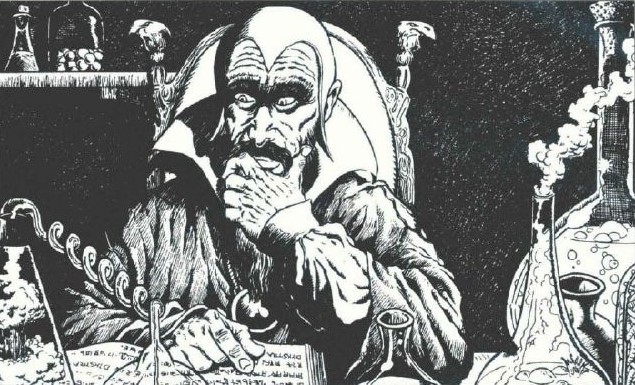
my face trying to parse these rules
Potions: To start, both wizards and priests need 1d3+1 weeks to research the formula. This step only has to be done once for a particular potion, and the fact that I was half expecting this not to be spelled out speaks volumes of my opinion of 2nd edition. While you can’t just outright use someone else’s recipe for Reasons, having one does reduce the research time by one week. To brew a potion, a wizard or priest has to be able to cast the spell the potion would replicate. For potions at least a table is provided to give appropriate schools and spheres. The level of the spell the potion duplicates is added to the base difficulty, and if no spell exists that matches it then the modifier is equal to the combination of spells that approximates the effect. That’s... different from the rules for creating any other magic item. Somewhat balancing this is that the base creation percentage is 70% + 2% per level. Otherwise the rules are the same. Starting with potions the book provides suggestions as to what steps go into manufacturing an item that a DM can designate as needing to be special. For potions, these steps are distillation, infusion, evaporation, fermentation, extraction of vital oils, separation, leaching and purification. Due to the layout, it strongly implies that only wizards need to follow special processes, so does this mean priests can more easily make potions?

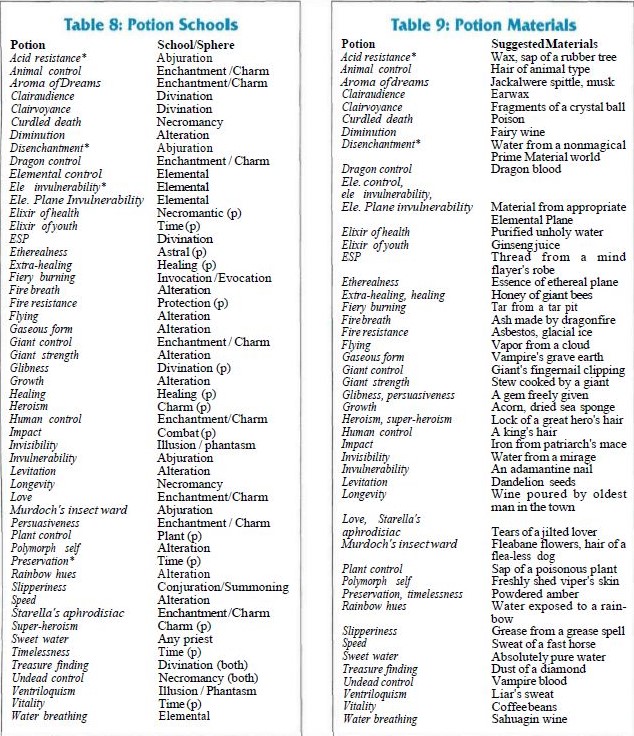
After potions are explained we move onto permanent and rechargeable items, plus about a page of information that hasn’t already been spelled out before. About the only new info is that the cost of the raw materials should be between 1,000 x 10,000 gp per difficulty point, which is ten times what was given earlier in the book.
Here are some highlights from the different types of permanent items:
Rings: Apparently the 2nd Ed Dungeon Master’s Guide stated that every magic ring looks like the One Ring, so that needed to be errated. Special processes could be applied to making a mold, melting the alloy, casting, welding, tempering, setting stones, and polishing.
Wands and Rods: “Get past the notion that wands are made only of wood and rods of iron”. I am always amazed at how nerd-
 pops up in the most inconsequential places. Special procedures can be applied to lathing, carving, steeping, polishing, tooling, enameling, sanding and mounting.
pops up in the most inconsequential places. Special procedures can be applied to lathing, carving, steeping, polishing, tooling, enameling, sanding and mounting.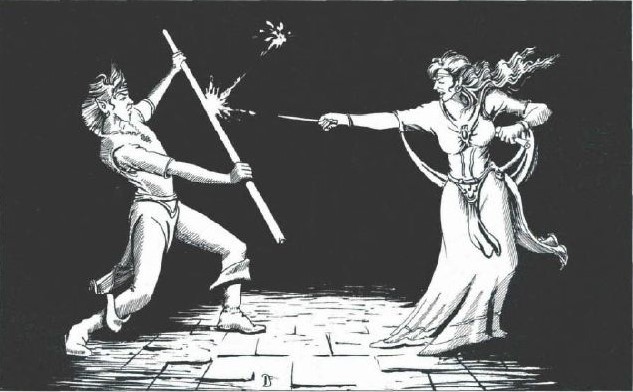
Latinus Arcania!
Staves: “These are almost always made of wood, if only because other materials tend to be too heavy.” If you say so, Book of Artifacts. Otherwise, the special processes are pretty much the same that could be used for wands and rods.
Weapons: Because of weapon restrictions, most magical weapons are going to be daggers or maces-at least that’s what this book says, I’d have to see if the random magic item tables from the DMG actually supports this. “Fortunately weapons last a long time thus accounting for the preponderance of enchanted blades in most campaigns”. But wouldn’t that also apply to daggers and-oh forget it, anything non-rule related is dumb as fuck in this chapter. The book says that most weapons’ manufacture includes forging, tempering, etching, casting, inlay, piercing, sharpening, and/or balancing. Certain weapons or weapon ammo can also require cutting, carving, riveting, planing, fletching and more.
Armor: Armor creation involves most of the steps needed to make weapons. Other steps include fitting, welding, sewing, chasing, lacing, boiling, engraving, gilding, painting, riveting, chiseling, embossing, and lacquering.
Miscellaneous Items: Thankfully we don’t get a full breakdown of making every magic item from the DMG.
Creating a permanent magic item (once all the materials are gathered) is 2d6 months. The base chance of success is 60%. If the character doesn’t have the background or proficiencies to make an item, then a PC that does or an NPC can do it, but the character applying the spells must be present the entire time.
Now, there is one thing that I have been leaving out, and that is the examples of special materials that might be needed to make a magic item. That’s because they are spread out over the chapter and I want to consolidate it in one place. The idea is that you can’t just use a normal chunk of metal or wood or whatever to contain the magical powers, so the character needs to seek out special components. In practice, this makes the creation of a magical item an adventure in itself, something the book is cognizant of. Here’s some of the special materials it suggests that are at least straightforward:
- skin of a water snake for a ring of water walking
- ground diamond to make dust of stoneskin
- coal from a “particular hill” to forge a +1 weapon
- adamantite wire for a magic rod
- polishing a wand in giant wasp venom
- tempering a sword in orc wine
- gem hatched from a poisonous egg
- a piece of lightning for making a wand
- soaking in water from a mirage
- forging a weapon in concentrated sunlight
This is my big problem with this chapter, and the reason I wanted to review the book. These rules set up a cool adventure that would probably last several sessions, but the end result is maybe one standard magic item out of the Dungeon Master’s Guide. Also there’s a 1-in-20 chance that the players set back their characters by making a cursed item. And these rules are in a book full of extraordinary artifacts with several stories about how they came into existence. It’s a problem with a lot of 90s RPGs, where there is a half-hearted attempt to extend narrative levers to players, but the end result is patronizing. “You can make a magic item, player, but it’ll never be as cool as the ones we came up with!”
There’s one more part of this chapter, and that is creating intelligent magical items. The book makes the cost of making one prohibitively expensive, to the point that no player would ever do it. Why not just say players can’t make it? Well how else would you explain where intelligent weapons are from!?
 Basically, a spellcaster has to transfer his conscious into the item. This kills the characters, and the PC loses all his abilities. We’re told that the weapon has an ego score, but given no indication how to calculate it.
Basically, a spellcaster has to transfer his conscious into the item. This kills the characters, and the PC loses all his abilities. We’re told that the weapon has an ego score, but given no indication how to calculate it.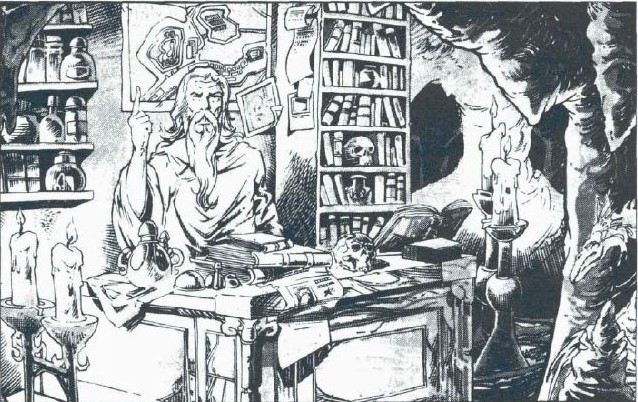
Huzzah, these rules are balls!
And with that, I toss the Book of Artifact into the cracks of Mount Doom. It’s an interesting example of 2nd Edition D&D, but going over every entry is just not fun and will probably bind my will to Gary Gygax. I’ll be going back to reviewing Planescape stuff.